
- PP1, PP2 Grade 1 to 8 notes & exams
- PP1, PP2 Grade 1-8 schemes of work
- CBC assessment report books
- curriculum design (CBC)
- Form 1 notes and revision exams
- Form 2 notes and revision exams
- Form 3 notes and revision exams
- Form 4 notes and revision exams
- KCSE Marking Schemes
- set book guides
- secondary school schemes of work
- kasneb cpa revison kits questions and answers
- kasneb past papers
- 2023 KASNEB Fee Structure download
- Kenya Business Plans
- Crop and animal production guides
- Kenya Cookbook and recipes
- Novels and Story books
- kids story books
- guides and insight
- April Holiday Assignments NEW
- Secondary school revision , biology

Biology form 2 notes
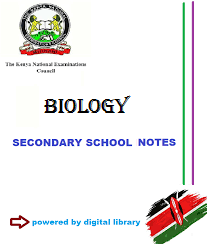
This document contains biology form 2 complete notes which are suitable for both students and teachers.It is well analysed and prepared with the aim of preparing KCSE candidates for biology examination.
In PDF format so that your print or read from any smartphone, laptop or computer.
Description
The document is written in a manner that both the candidates and teachers will immensely benefit from it.
Related Posts:

Related items
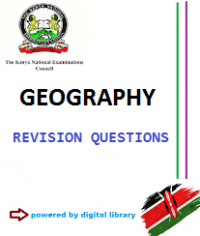
Geography form 1 revision questions
This document contains Geography form 1 revision questions which are suitable for both students and teachers. It is well analyzed and prepared with the aim of preparing KCSE candidates,

Biology essays questions with answers
This document contains over 60 Biology essays questions with answers..It is suitable for both students and teachers.It is well analysed and prepared with the aim of preparing KCSE candidates for biology exam.
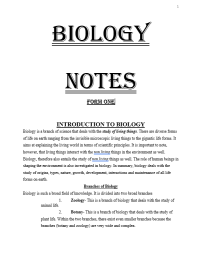
Biology form 1 notes
biology form 1 notes are aggregated from the various high school approved text books, including KLB biology form 1, Finder biology form 1, etc. The biology notes cover all topics. suitable for both students and teachers. It is well analyzed and prepared with the aim of preparing KCSE candidates for biology exam.

Mathematics form 1 revision questions
This document contains Mathematics form 1 revision questions which are suitable for both students and teachers. It is well analyzed and prepared with the aim of preparing KCSE candidates,
Biology revision questions with answers
- This document contains Biology form 1-4 revision questions with answers.With all topics tested.It is suitable for both students and teachers.It is well analysed and prepared with the aim of preparing KCSE candidates for biology paper 1 & 2 exam.
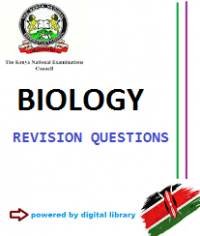
Biology form 1 revision questions
This document contains Biology form 1 revision questions which are suitable for both students and teachers.It is well analysed and prepared with the aim of preparing KCSE candidates,
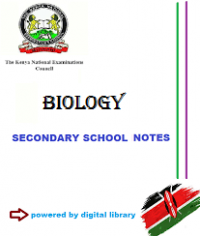
Biology form 1-4 notes
This document contains Biology form 1-4 complete notes which are suitable for both students and teachers.It is well analysed and prepared with the aim of preparing KCSE candidates for biology paper 1 & 2 in the examination.
Biology form 3 notes
This document contains biology form 3 complete notes which are suitable for both students and teachers.It is well analysed and prepared with the aim of preparing KCSE candidates for biology examination.
Biology form 4 notes
This document contains biology form 4 complete notes which are suitable for both students and teachers.It is well analysed and prepared with the aim of preparing KCSE candidates for biology examination.

Free Biology Essay Examples & Writing Tips
Don’t know what to write about in your essay on biology? Looking for good biology essay examples for inspiration? This article has all you need!
A biology essay is a type of academic paper that focuses on a particular topic of biology. It can discuss animal life, cycles in biology, or a botanic subject. You will need to demonstrate your critical thinking skills and provide relevant evidence to support your perspective.
On this page, you will find examples of biology essays. You will also find here tips and topics prepared by our experts . They can assist you in nailing your short or extended essay.
Areas of Research for Biology Essays
If you’ve been assigned to write a biology essay, you probably know which area of research you have to choose. However, it might be beneficial to explore other available scopes. It’s useful for both interdisciplinary study and the cases when you are free to pick your area of research. In this section, let’s figure out what you can study in biology.
Here are biological areas of research you should be familiar with:
- Cancer Biology studies this type of disease to prevent, detect, diagnose and cure it. The ultimate goal of such biologists is to eliminate cancer.
- Cell Biology is a branch that studies the structure, function, and behavior of cells. Here, biologists study healthy and sick cells to produce vaccines, medication, etc.
- Biochemistry is an application of chemistry to the study of biological processes on cell and molecular levels. It is a cross-discipline between chemistry and biology. The focus is on the chemical processes of living organisms.
- Computation Biology is a study of biological data that develops algorithms and models to understand biological systems. Here, scientists either work for institutions or research for private enterprises.
- Genetics is an area that focuses on the study of genes and genetic variations for health benefits. It looks at the way DNA affects certain diseases.
- Human Disease is an area within which scientists study different diseases. The field covers cancer, developmental disorders, disease genes, etc.
- Immunology is a branch of biology that focuses on immunity. Immunologists look at the way the body responds to viruses as a way to protect the organism.
- Microbiology studies all living organisms that are too small for our eye to see. It includes bacteria, viruses, fungi, and other microorganisms.
- Neurobiology is the study of the nervous system. Biologists examine the way the brain works and look into brain illnesses.
- Stem Cell and Developmental Biology seeks to examine how the processes behind stem cell’s ability transform cells. The biologists in this area use the power of stem cells to model human illnesses.
Essay on Biology: Writing Tips
Want to know how to start a biology essay? Wondering about the best way to write your essay on biology? Then check out the following tips.
When you’re writing about biology, pay attention to the following features:
- Introduction . Just as in any other form of academic writing, the first section of your paper introduces the subject. Here, explain why your ideas are relevant to biology as a science.
- Thesis Statement. The final one or two sentences of the first paragraph should include your original hypothesis and experiment. You will be proving them in the main body. You do not have to include the results as the reader will encounter them later. If you’re struggling with this part, try our thesis generator .
- Main Body. In this part, write about all the experiments in detail. Often, teachers require to include visual aid to prove your point. For Zoology, Anatomy, Botany, it is pretty easy to find some photos and illustrations.
- Conclusion. Here, restate your thesis. Reemphasize the most critical aspects described in the main body. You can do it by using our summarizing tool . The goal of this last paragraph is to leave an everlasting impression on the reader.
Thank you for reading our article. We hope you found it helpful. Share it with your class peers who also study biology. Additionally, have a look at the biological essay examples below.
810 Best Essay Examples on Biology
Grass and its importance, the benefits of animals to humans essay.
- Words: 1166
Biology of Grasses: Description and Importance
The effect of temperature on amylase activity.
- Words: 1293
Effects of Vinegar on the Germination Rate of Mung Beans Seeds
- Words: 1750
Ubiquity of Microorganisms
- Words: 2210
Anaerobic Respiration and Its Applications
- Words: 1274
Bronfenbrenner’s Bioecological System Theory
- Words: 1827
Seed Germination Experiment: Results and Discussion
Strawberries history.
- Words: 1484
Dark or Light Skin: Advantages and Disadvantages
Mitosis and meiosis in onion root tip.
- Words: 1691
Botany and Taxonomy of the Onion
- Words: 2414
Nanobiotechnology, Its Advantages and Disadvantages
Substrate concentration and rate of enzyme reactions.
- Words: 1730
Browning Reactions Explained
Mung seed germination patterns under varying ph values, pets and people, similarities and differences of photosynthesis and cellular respiration, the c-fern plant laboratory experiment.
- Words: 1101
Aspects, Importance and Issues of Biodiversity
Transpiration process in plants, osmosis through a potato slice dipped in solutions of varying concentrations.
- Words: 1075
Lemon, Its Origin and Production
- Words: 1115
Rabbit Muscular System Dissection Report
Seed germination and osmosis.
- Words: 1127
Vitamin A: Description and Usage
Characteristics of adult development.
- Words: 1311
Pollutants Effects on Cellular Respiration Rate
- Words: 1434
Description of Mitosis and Meiosis
Microbiology: zygomycota, ascomycota and basidiomycota, responsible house plant keeping.
- Words: 2262
Importance of the Brain in Human Body
Biochemistry dogmas and their impacts on biotechnology, mitosis in onion root and whitefish blastula, ethnobotanical uses of plants.
- Words: 1938
Photosynthesis As A Biological Process
The insect effect on human life, the characteristics and importance of nervous system.
- Words: 1705
Archaea and Bacteria Prokaryotes Dichotomous Keys
The human family tree development, co-evolution: angiosperms and pollinating animals, understanding the effects of quantity of light on plants growth.
- Words: 1089
Different Ecosystems and Living Things
Common biochemical cycles, a study of the brine shrimps and their natural environment.
- Words: 1937
The Digestive System in the Human Body
The thermoregulation is and its importance, digestion, absorption and assembly of proteins.
- Words: 1456
Anaerobic Capacity: Power Endurance and Fatigue Index
Life in the bottom of the ocean and its protection.
- Words: 1529
Cell Organelles, Their Functions, and Disease
- Words: 1195
Olfactics and Its Importance for Living Beings
- Words: 1446
The Function and Structures of the Human Heart
Microbial growth and effect of ph on it.
- Words: 1330
The Integumentary and the Skeleton System
- Words: 1100
Cells, Tissues, and Major Organs Systems
- Words: 2269
Dugesia, a Planarian With Its Peculiar Characteristics
- Words: 3207
Forensic Procedures: Hairs and Fibres
- Words: 2067
The Process of a Prenatal Child’s Development
Eukaryotic and prokaryotic cells: key differences, corn plant’s developmental stages, invertase enzyme: description and role.
- Words: 1151
Molecular Biology. Production of pET28b and EGFP Clones
- Words: 4609
Cane Toad: Introduction and Threat
- Words: 1018
Operant and Respondent Conditioning
Digestive journey of cheeseburger, climate change and threat to animals, environmental microbiology overview.
- Words: 3298
Natural Sciences. The Phenol Red Broth Test Experiment
- Words: 1156
Plant Growth and Development With Music
Marine life in united arab emirates.
- Words: 1474
Telescope and Microscope Discovery Combo
- Words: 1932
Vaquita – Endangered Species
- Words: 1367
Whether or Not Human Cloning Should Be Allowed
- Words: 1350
The Anatomy and Physiology of the Nervous System of a Rat
- Words: 1612
Falling in Love as Part of Natural Selection
- Words: 1085
Basic and Applied Biology: Key Differences
Is earthworm beneficial or harmful to humans, epithelial tissue: structure and functions, case study: human body water balance, membrane hands-on laboratory report.
- Words: 1176
DNA Barcoding Sequence Analysis of Unknown Plant
- Words: 1315
The Kingdom Fungi: The Structure, Characteristics
Plant resource allocation: materials and methods.
- Words: 1182
Cell Counting and Measurement Under Magnification
- Words: 1641
The DNA Extraction Procedure: Scientific Experiment
A brief discussion of animal and plant cells, psychophysics: definition & fundamentals.
- Words: 1606
A Peptic Ulcer: Medical Analysis
- Words: 1185
Reproductive Isolation and Its Potential Effects
Soil impact on the growth of plants.
- Words: 1227
History Of Biotechnology
- Words: 1908
Yeast and the Fermentation Process
Lipids: fatty acids and glycerols, biology: photosynthesis and respiration, the effect of different shampoos on the bacteria growth.
- Words: 1737
“The Egg and the Sperm” by Emily Martin Critique
- Words: 2577
Botany and Zoology in the Classroom
- Words: 1631

Evolution of Predator and Prey Pairings
Cell culture and biomedical applications.
- Words: 1485
Rosalind Franklin: The Discovery of the DNA Structure
Food macromolecules – lipids, carbohydrates, and proteins, history of potatoes, their vatiety, and popularity.
- Words: 1233
Planting Bamboo: The Role of Photosynthesis
The importance of sleeping and dreaming, researching the physiology of the eye.
- Words: 1122
How SCOBY Changes Its Environment: Lab Experiment
- Words: 1214
Microbiology and Its Role in Healthcare
Microbiological studies, applications, and current discoveries, how the human eye works analogous to a camera, brine shrimp habitat, the genus rosa’s adaptation to the environment.
- Words: 1144
The Euphorbia Plant Modification and Adaptation
Human circulatory system and evolution, physiology of uromastyx aegyptia.
- Words: 1340
A Study of “Escherichia Coli”
Melanin theory as a pseudoscientific claim.
- Words: 1645
Vertical Stratification
Domesticated, cultivated, and wild species.
Welcome, Login to your account.
Recover your password.
A password will be e-mailed to you.

BIOLOGY TOPIC BY TOPIC QUESTIONS AND ANSWERS
Biology topic by topic questions and answers , you can download all the biology questions and answers for all topics for form 1, form 2, form 3 and form 4., the list includes all biology questions with their answers. use the links below. click on a link to a specific material., form 4_heredity questions, form 4_heredity answers, form 4_cell divsion questions, form 4_cell division answers, form 4_applied genetics questions, form 4_applied genetics answers, form 4_4. support and movement in plants and animals q, form 4_4. support and movement in plants and animals a, form 4_3. reception response and co ordination q, form 4_3. reception response and co ordination a, form 4_2. evolution q, form 4_2. evolution a, form 4_1. genetics q, form 4_1. genetics a, form 4 - support and movement in plants and animals questions - teacher.co.ke, form 4 - support and movement in plants and animals a - teacher.co.ke, form 4 - reception, response and co-ordination questions - teacher.co.ke, form 4 - reception, response and co-ordination a - teacher.co.ke, form 4 - genetics questions - teacher.co.ke, form 4 - genetics a - teacher.co.ke, form 4 - evolution questions - teacher.co.ke, form 4 - evolution a - teacher.co.ke, form 3_plant reproduction questions, form 3_plant reproduction answers, form 3_personal health questions, form 3_personal health answers, form 3_human reproduction questions, form 3_human reproduction answers, form 3_asexual reproduction questions, form 3_asexual reproduction answers, form 3_4. growth and development q, form 3_4. growth and development a, form 3_3. reproduction in plants and animals q, form 3_3. reproduction in plants and animals a, form 3_2. ecology q, form 3_2. ecology a, form 3_1. classification ii q, form 3_1. classification ii a, form 3 - reproduction in plants and animals questions - teacher.co.ke, form 3 - reproduction in plants and animals a - teacher.co.ke, form 3 - growth and development questions - teacher.co.ke, form 3 - growth and development a - teacher.co.ke, form 3 - ecology questions - teacher.co.ke, form 3 - ecology a - teacher.co.ke, form 3 - classification ii questions - teacher.co.ke, form 3 - classification ii a - teacher.co.ke, form 2_transport plants questions, form 2_transport plants answers, form 2_skin temperature questions, form 2_skin temperature answers, form 2_food diet questions, form 2_food diet answers, form 2_excretion questions, form 2_excretion answers, form 2_digestion questions, form 2_digestion answers, form 2_breathing questions, form 2_breathing answers, form 2_blood circulation questions, form 2_blood circulation answers, form 2_5. excretion and homeostasis q, form 2_5. excretion and homeostasis a, form 2_4. respiration q, form 2_4. respiration a, form 2_3. gaseous exchange q, form 2_3. gaseous exchange a, form 2_2. transport in animals q, form 2_2. transport in animals a, form 2_1. transport in plants q, form 2_1. transport in plants a, form 2 - transport in plants questions - teacher.co.ke, form 2 - transport in plants a - teacher.co.ke, form 2 - transport in animals questions - teacher.co.ke, form 2 - transport in animals a - teacher.co.ke, form 2 - respiration questions - teacher.co.ke, form 2 - respiration a - teacher.co.ke, form 2 - gaseous exchange questions - teacher.co.ke, form 2 - gaseous exchange a - teacher.co.ke, form 2 - excretion and homeostasis questions - teacher.co.ke, form 2 - excretion and homeostasis a - teacher.co.ke, form 1_respiration questions, form 1_respiration answers, form 1_photosynthesis questions, form 1_photosynthesis answers, form 1_diffusion osmosis questions, form 1_diffusion osmosis answers, form 1_cells tissues questions, form 1_cells tissues answers, form 1_cell chemistry questions, form 1_cell chemistry answers, form 1_6. nutrition in animals q, form 1_6. nutrition in animals a, form 1_5. nutrition in plants q, form 1_5. nutrition in plants a, form 1_4. cell physiology q, form 1_4. cell physiology a, form 1_3. the cell q, form 1_3. the cell a, form 1_2. classification i q, form 1_2. classification i a, form 1_1. introduction to biology q, form 1_1. introduction to biology a, form 1 - the cell questions - teacher.co.ke, form 1 - the cell a - teacher.co.ke, form 1 - nutrition in plants questions - teacher.co.ke, form 1 - nutrition in plants a - teacher.co.ke, form 1 - nutrition in animals questions - teacher.co.ke, form 1 - nutrition in animals a - teacher.co.ke, form 1 - introduction to biology questions - teacher.co.ke, form 1 - introduction to biology a - teacher.co.ke, form 1 - classification i questions - teacher.co.ke, form 1 - classification i a - teacher.co.ke, form 1 - cell physiology questions - teacher.co.ke, form 1 - cell physiology a - teacher.co.ke.
Active English Grammar 1-Teacher.co.ke
Active english grammar 2-teacher.co.ke, active english grammar 3-teacher.co.ke, active english grammar 4-teacher.co.ke, active english grammar 5-teacher.co.ke, active english grammar 6-teacher.co.ke, basic english grammar-teacher.co.ke, class 6 cre notes complete-teacher.co.ke, class 7 cre notes complete-teacher.co.ke, class 8 cre notes complete-teacher.co.ke, english grammar notes complete-teacher.co.ke, grade 4 cre notes complete-teacher.co.ke, grade 4 cre notes-teacher.co.ke, guide to composition writing-teacher.co.ke, insha notes complete-teacher.co.ke, kiswahili std 5 notes-teacher.co.ke, kiswahili std 7 notes-teacher.co.ke, kiswahili 4 complete notes-teacher.co.ke, kiswahili 5 complete notes-teacher.co.ke, kiswahili 7 complete notes-teacher.co.ke, kiswahili 8 complete notes-teacher.co.ke, kiswahili grade 4 notes-teacher.co.ke, kiswahili insha-teacher.co.ke, kiswahili std 8 notes-teacher.co.ke, mathematics-revision-notes-std-7-8.
- Next Page »
You cannot print the contents of this website.
- LESSON NOTES
- LESSON PLANS
- 2021 SCHEMES
- POWERPOINT NOTES
- FORM 1 EXAMS
- FORM 2 EXAMS
- FORM 3 EXAMS
- FORM 4 EXAMS
- COMPREHENSIVE 1-4
- TOPICAL QUESTIONS
- K.C.S.E SYLLABUS
- REVISION MOCKS
- K.C.S.E REVISION
- 2018 K.C.S.E PAPERS
- 2017 K.C.S.E PAPERS
- 2016 K.C.S.E PAPERS
- 2015 K.C.S.E PAPERS
- 2014 K.C.S.E PAPERS
- 2013 K.C.S.E PAPERS
- 2012 K.C.S.E PAPERS
- 2011 K.C.S.E PAPERS
- 2010 K.C.S.E PAPERS
- 2008 K.C.S.E PAPERS
- 1996-2009 K.C.S.E PAPERS
- TOPICAL PAST PAPERS
- SECONDARY F1-4
- REVISION NOTES STD 4-8
- SCIENCE NOTES STD 4-8
- SOCIAL STUDIES NOTES STD 4-8
- COMPREHENSIVE NOTES STD 4-8
- SCIENCE POWERPOINT
- SOCIAL STUDIES POWERPOINT
- K.C.P.E TOPICAL REVISION
- BEST & WORST INSHAS
- 2018 K.C.P.E PAST PAPERS
- 2000-2017 K.C.P.E PAPERS
- SCHEMES STD 4-8
- GRADE 1 EXAMS
- GRADE 2 EXAMS
- GRADE 3 EXAMS
- GRADE 1 NOTES & CLASS READERS
- GRADE 2 NOTES & CLASS READERS
- GRADE 3 NOTES & CLASS READERS
- GRADE 1 SCHEMES OF WORK
- GRADE 2 SCHEMES OF WORK
- GRADE 3 SCHEMES OF WORK
- GRADE 1 CURRICULUM
- GRADE 2 CURRICULUM
- GRADE 3 CURRICULUM
- GRADE 1-3 SYLLABUS
- Now Trending:
- KDF releases burial sche...
- Schools’ Portal- G...
- No police officers for K...
- Knec to roll out end of ...
Form 2 Biology Exams and Marking Schemes Free
NAME :……………………………………………………ADM NO……………….
CANDIDATE’S SIGNATURE………………………….DATE:………………….
TIME: 2 HOURS
JOINT EVALUATION EXAMINATION
INSTRUCTIONS TO CANDIDATES
- Write your name and admission number in the spaces provided above.
- Answer ALL questions in the spaces provided
- All working must be clearly shown where necessary
- Students should check the question paper to ascertain that all pages are printed as indicated and that no questions are missing
This paper consists of 9 printed pages:
NB: Candidates should check the question paper to ensure that all the printed pages are printed as indicated and no question is missing.
FOR EXAMINER’S USE ONLY
Also read..
BIOLOGY FORM ONE SUMMARIZED NOTES
Biology Form one to four exams, notes and revision materials
BIOLOGY FORM FOUR SUMMARIZED NOTES
BIOLOGY FORM TWO SUMMARIZED NOTES
Biology notes form 1-4; Free KCSE downloads
Free Biology notes, revision questions, KCSE past Papers, Exams, Marking Schemes, Topical revision materials, Syllabus and Many more
BIOLOGY FORM ONE NOTES FREE
BIOLOGY FORM THREE SUMMARIZED NOTES
Biology notes (Updated form one to four free notes)
Biology Simplified Notes Form 1 to 4 Free
Biology Free notes and Exams for Form one to Four
BIOLOGY KCSE MARKING AND SETTING TIPS IN LINE WITH EMERGING TRENDS
Biology topical questions and answers
Biology KCSE Past Papers and all marking schemes free downloads
Biology free lesson plans for all topics (Form one to four)
CBC Senior School Subjects (Grade 10, 11, 12)
CRE free lesson plans for all topics (Form one to four)
History and Government free lesson plans for all topics (Form one to four)
Free Secondary School Exams and Marking schemes (Form 1 to 4)
Syllabus For All Secondary Schools Per Subjects (Latest Syllabus)
English free lesson plans for all topics (Form one to four)
Free Physics notes, revision questions, KCSE past Papers, Exams, Marking Schemes, Topical revision materials, Syllabus and Many more
FORM 4 EXAMINATIONS AND MARKING SCHEMES: ALL SUBJECTS FOR KCSE CANDIDATES- OVER 1,000 PAPERS
Form 4 Term 1-3 Free Exams and marking schemes; All subjects downloads
FORM 3 ALL SUBJECTS EXAMS, ASSIGNMENTS: FREE TERM 1-3 EXAMS & ANSWERS
Updated Secondary School Notes form one to four Free Downloads (All subjects Comprehensive Notes)
Physics free lesson plans for all topics (Form one to four)
- State the use of each of the following. (3mks)
- Ribosomes ……………………………………………………………………………………………………
- Mitochondria ……………………………………………………………………………………………………
- Lysosome …………………………………………………………………………………………………..
- A ‘dolf’ is an offspring between a wolf and a dog. This animal is infertile. Give a reason for this. (1mk)
……………………………………………………………………………………………………………………………………………………………………………………………………………………………………………………………………………………………………………………………….
- a) What is a hypotonic solution? (1mk)
……………………………………………………………………………………………………………………………………………………………………………………………………………………..
- b) Explain the changes that will be observed if a drop of human blood is added to this solution. (3mks)
……………………………………………………………………………………………………………………………………………………………………………………………………………………………………………………………………………………………………………………………………………………………………………………………………………………………………………………………………………………………………………………………………………………..
- c) State four importance of osmosis to plants. (3mks)
………………………………………………………………………………………………………………………………………………………………………………………………………………………………………………………………………………………………………………………………………………………………………………………………………………………………………………………………
- Give two main branches of Biology. (2mks)
- A certain animal has no incisors and no canine but has six premolars and 6 molars in the upper jaw. In the lower jaw there are 6 incisors, 2 canines, 6 premolars and 6 molars.
- What is the dental formula of the animal? (1mk)
………………………………………………………………………………………………………………………………………………………………………………………………………………
- Calculate the total number of teeth. (1mk)
- Giving reasons, state the mode of feeding. (2mks)
- State and explain three environmental factors that affect transpiration. (6mks)
………………………………………………………………………………………………………………………………………………………………………………………………………………………………………………………………………………………………………………………………………………………………………………………………………………………………………………………………………………………………………………………………………………………………………………………………………………………………………………………………………………………………………………………………………………………
- A man is of group A+.
- What type of antigen does his blood have? (1mk)
………………………………………………………………………………………………………
- What types of antibodies are present in his blood? (1mk)
- Which blood groups can he receive blood from? (2mks)
- (a) How is the mitochondrion adapted to its function? (2mks)
………………………………………………………………………………………………………………………………………………………………………………………………………………………………………………………………………………………………………………………………………………………………………………………………………………………………
(b) In which part of the mitochondrion does aerobic respiration take place? (1mk)
- State four structural differences between arteries and veins. (4mks)
- State three characteristics of a respiratory surface. (3mks)
………………………………………………………………………………………………………………………………………………………………………………………………………………………………………………………………………………………………………………………………………………………………………………………………………………………………………………………………………………………………………………………………………
- The diagram below illustrates the structure of a gill from a bonny fish.
- Name the structures labelled A, B and C and give their functions. (6mks)
A……………………………………………………………………………………………………………………………………………………………………………………………………………
B……………………………………………………………………………………………………………………………………………………………………………………………………………
C……………………………………………………………………………………………………………………………………………………………………………………………………………
- How is structure labeled C adapted to its function? (1mk)
………………………………………………………………………………………………………………………………………………………………………………………………………………………………………………………………………………………………………………………
- State the functions of the following parts of a microscope. (3mks)
- Diaphragm ………………………………………………………………………………………………….
- Condenser ………………………………………………………………………………………………….
- Fine adjustment knob
………………………………………………………………………………………………
- The diagram below represents a transverse section of a part of a young plant and seen under light microscope.
- From which part of the plant was the specimen obtained? (1mk)
- Name the parts labelled J,P and M. (3mks)
J……………………………………………………………………………………………………..
P…………………………………………………………………………………………………….
M……………………………………………………………………………………………………
- Name the functions of the part labelled M. (1mk)
- State three factors that determine the amount of energy a human requires in a day. (3mks)
- State two defects of circulatory system. (2mks)
- b) State three adaptations of erythrocytes to their functions. (3mks)
- A jet aeroplane is able to move and oxidise fuel to carbon (IV) oxide and water yet it is not classified as a living thing. List other characteristics of living things not shown by a jet aeroplane. (3mks)
- Outline three applications of anaerobic respiration. (3mks)
- Define the following terms. (3mks)
- Excretion ……………………………………………………………………………………………………………………………………………………………………………………………………
- Secretion ……………………………………………………………………………………………………………………………………………………………………………………………………..
- Homeostasis …………………………………………………………………………………………………………………………………………………………………………………………………….
- The diagram below illustrates a nephron from a mammalian kidney.
- Name the parts labelled A, B,C and D. (4mks)
A…………………………………………………………………………………………………
B…………………………………………………………………………………………………
C…………………………………………………………………………………………………
D…………………………………………………………………………………………………
- Name the process represented by arrows. (1mk)
…………………………………………………………………………………………………
- Name three substances that are completely reabsorbed in the part labelled W in a normal human being. (3mks)
…………………………………………………………………………………………………………………………………………………………………………………………………………………………………………………………………………………………………………………………………………………………………………………………………………
- Name the component of blood that do not enter the renal tubule in mammals. (1mk)
…………………………………………………………………………………………………..
- How does the part labelled C of a camel compare with that of a hippo? (2mks)
………………………………………………………………………………………………………………………………………………………………………………………………………………………………………………………………………………………………………
___________________________________________________________________
BIOLOGY FORM 2 MARKING SCHEME
- State the use of each of the following. (3mks)
- Ribosomes – site for protein synthesis
- Mitochondria – site for respiration in a cell
- Lysosome – contains lytic enzymes that destroys worn out cells/cell organels
Because the wolf and the dog do not belong to the same species hence they give rise to infertile offsprings.
solution having less solutes than solvent molecules compared to cell sap.
The RBC will be hypertonic to the solution. Water molecules from solution will move into RBC by osmosis. The cell swell, enlarge and burst since they lack cell wall.
- c) State four importance of osmosis to plants. (3mks)
- Helps in the opening and closing of the stomata.
- Aid in uptake of water by root hairs from the soil .
- Facilitates feeding in insectivorous plants.
- Enhances turgidity of cells in herbaceous plants giving them support.
- Assist in movement of water from cell to cell
i c pm m
Herbivorous/herbivory, they lack upper incisors and canines
- State and explain three environmental factors that affect transpiration. (6mks)
- Humidity – at high humidity, the rate of transpiration is low while at low humidity the transpiration rate is high
- Wind – transpiration rate is higher during a windy day because of increased evaporation on leaf surface.
- Temperature – at high temperature, transpiration rate is high while at low temperature the transpiration rate is low
- Antigen A, rhesussfactor
- Which blood groups can he receive blood from? (2mks)
- A + and O +
- Has cristae which provide large surface area for attachment of respiratory enzymes.
- Has matrix which contains numerous respiratory enzymes
- Thin epithelium for rapid diffusion of respiratorygases
- Large surface area for rapid diffusion of respiratory gases
- Moist surface for respiratory gases to dissolve
- Well vascularised to transportrespiratory gases
A: Gill bar – hold gill filament and rakers in position
B: Gill rakes – protect delicate gill filament from damage
C: Gill filament site for gaseous exchange
- Numerous providing large surface area for gaseous exchange.
- Have thin epithelium lining thus reducing distance over which gases diffuse
- Have rich supply of blood vessels to transport respiratory gases/ create a steep diffusion gradient
- State the functions of the following parts of a microscope. (3mks)
- Diaphragm it regulates the amount of light passing through the condenser to the specimen
- Condenser concentrates light rays into state to illuminate the specimen on stage
Raises and lowers body tube over short distance to bring image into shaper focus.
- (Dicotyledonous )stem
J : Epidermis
- Transports water and mineral salts.
- Basal metabolic rate
- Varicose veins
- Hypertension
- Arteriosclerosis
- b) State three adaptations of erythrocytes to their functions. (3mks)
- Have biconcave shape that crates a large surface area for diffusion of gases
- Contains haemoglobin which readily combines with oxygen
- Lack nucleus which creates more space for packaging of haemoglobin
- Numerous to offer a large surface area for diffusion of gases.
- Thin for the respiratory gases to take short distance in movement by difussion
- Reproduction
- Irritability
- Manufacturing of organic acids
- Sewage treatment
- Making of silage
- Production of biogas
- Baking industry
- Brewing industry
- Excretion: removal of metabolic waste products from the body of an organism
- Secretion: production of substances from cells which are useful to the body
- Homeostasis: it is maintenance of constant internal conditions despite fluctuations in the external environment
A: bowman’s capsule
B: glomerulus filtrate
C : loop of henle
D : collecting duct
Ultrafiltration
- Amino acids
- Name the components of blood that do not enter the renal tubule in mammals. (1mk)
- Blood cells
- Plasma proteins
- it is long and penetrates deep in medulla while in a hippo it is short and confined to the cortex
Related Posts
- Form 1 Mathematics Notes
- Form 2 Mathematics Notes
- Form 3 Mathematics Notes
- Form 4 Mathematics Notes
- Form 1 Mathematics Topical Questions and Answers
- Form 2 Mathematics Topical Questions and Answers
- Form 3 Mathematics Topical Questions and Answers
- Form 4 Mathematics Topical Questions and Answers
- Form 1 Functional Writing Notes
- Form 2 Functional Writing Notes
- Form 3 Functional Writing Notes
- Form 4 Functional Writing Notes
- Poetry Notes
- Grammar Notes
- Oral Literature Notes
- Oral Skills Notes
- Guide to Blossoms of the Savannah Summarized Notes - Easy Elimu
- A Doll's House
- The Pearl Study Guide
- Memories We Lost and Other Stories Study Guide
- Inheritance Study Guide
- A Silent song and Other Stories Guide
- Fathers of Nations Guide
- An Artist of the Floating World Guide
- The Samaritan Guide
- Sarufi na Matumizi ya Lugha
- Isimu Jamii Notes
- Fasihi Notes
- Ushairi Notes
- Mwongozo wa Kuandika Insha
- Tumbo Lililoshiba na Hadithi Nyingine
- Mwongozo wa Kigogo
- Mwongozo wa Chozi La Heri - Chozi la Heri Notes PDF
- Mwongozo wa Bembea ya Maisha - Bembea ya Maisha Notes PDF
- Mwongozo wa Nguu za Jadi
- Mwongozo wa Mapambazuko ya Machweo na Hadithi Nyingine
- Biology Form 1 Notes
- Biology Form 2 Notes
- Biology Form 3 Notes
- Biology Form 4 Notes
- Biology Essays
- Form 1 Biology Topical Revision Questions and Answers
- Form 2 Biology Topical Revision Questions and Answers
- Form 3 Biology Topical Revision Questions and Answers
- Form 4 Biology Topical Revision Questions and Answers
- Form 1 Chemistry Notes
- Form 2 Chemistry Notes
- Form 3 Chemistry Notes
- Form 4 Chemistry Notes
- All Chemistry Practicals Notes for KCSE and MOCKS
- Form 1 Chemistry Topical Revision Questions and Answers
- Form 2 Chemistry Topical Revision Questions and Answers
- Form 3 Chemistry Topical Revision Questions and Answers
- Form 4 Chemistry Topical Revision Questions and Answers
- IRE Form 1 Notes
- IRE Form 2 Notes
- IRE Form 3 Notes
- IRE Form 4 Notes
- Physics Form 1 Notes
- Physics Form 2 Notes
- Physics Form 3 Notes
- Physics Form 4 Notes
- CRE Form 1 Notes
- CRE Form 2 Notes
- CRE Form 3 Notes
- CRE Form 4 Notes
- Geography Form 1 Notes
- Geography Form 2 Notes
- Geography Form 3 Notes
- Geography Form 4 Notes
- History Form 1 Notes
- History Form 2 Notes
- History Form 3 Notes
- History Form 4 Notes
- Business Studies Form 1 Notes
- Business Studies Form 2 Notes
- Business Studies Form 3 Notes
- Business Studies Form 4 Notes
- Home Science Form 2 Notes
- Home Science Form 3 Notes
- Home Science Form 4 Notes
- Home Science Form 1 Notes
- Agriculture Form 1 Notes
- Agriculture Form 2 Notes
- Agriculture Form 3 Notes
- Agriculture Form 4 Notes
- Agriculture KCSE 2019 Project
- Computer Studies Form 1 Notes
- Computer Studies Form 2 Notes
- Computer Studies Form 3 Notes
- Computer Studies Form 4 Notes
- KCSE 2017 Reports
- 2018 Pre-Mocks
- 2019 Pre-Mocks
- 2022 Pre Mocks
- 2021/2022 Pre-Mock Past Papers
- 2023 Pre Mocks
- 2017 Mock Past Papers
- 2019 Mock Past Papers
- 2020 Mock Past Papers
- Mock Exam Papers 2021/2022 - Easy Elimu
- Mock Exam 2022 Questions and Answers
- Alliance Boys High School
- Maranda High School
- Form 1 Past Papers
- Form 2 Past Papers
- Form 3 Past Papers
- Form 4 Past Papers
- 2019 KCSE Prediction Papers
- 2020 KCSE Prediction Papers
- 2021 KCSE Prediction Papers
- 2022 KCSE Prediction Questions and Answers - EasyElimu
- KCSE Prediction 2023
- 2020 Post Mock Past Papers
- 2021/2022 Post Mocks
- 2023 Post Mocks
- Play Group: Activities, Homework and Syllabus
- 2023 PP1 Exams
- 2023 PP2 Exams
- Grade 1 Notes
- 2023 Grade 1 Exams
- Grade 2 Notes
- 2023 Grade 2 Exams
- Grade 3 Notes
- 2023 Grade 3 Exams
- Grade 4 Notes
- 2023 Grade 4 Exams
- Grade 5 Notes
- 2023 Grade 5 Exams
- Grade 6 Notes
- KPSEA Exams
- 2023 Grade 6 Exams
- Class 6 : Notes, Revision Papers and Syllabus
- Class 7 : Notes, Revision Papers and Syllabus
- Class 8 Notes
- 2023 Class 8 Exams
- 2023 Kcpe Prediction
- Grade 7 Notes
- 2023 Grade 7 Exams
- Pre Mock Exams 2024
- Form 4 Term 2 Opener Exams 2024
- Form 3 Exams 2024
- Form 2 Term 2 Opener Exams 2024
- Form 1 Term 2 Opener Exams 2024
- All Kiswahili setbook guides
- All English setbook guides
- Form 1 - 4 High School Notes
TRANSPORT IN PLANTS AND ANIMALS - Form 2 Biology Notes
Next Topic » RESPIRATION - Form 2 Biology Notes
Introduction
Internal structure of roots and root hairs.
- Internal structure of a Root Hair Cell
Absorption of Water and Mineral Salts
Structure and function of xylem, forces involved in transportation of water and mineral salts, importance of transpiration, factors affecting transpiration, the circulatory system, transport in insects, structure and function of the heart, pumping mechanism of the heart, structure and function of arteries, capillaries and veins, diseases and defects of circulatory system, composition of blood, abo blood groups, blood transfusion, lymphatic system, types of immunity, importance of vaccination, allergic reactions.

- Transport is the movement of substances within an organism.
- All living cells require oxygen and food for various metabolic processes.
- These substances must be transported to the cells.
- Metabolic processes in the cells produce excretory products which should be eliminated before they accumulate.
- The excretory products should be transported to sites of excretion.
- Organisms like amoeba are unicellular.
- They have a large surface area to volume ratio.
- The body is in contact with the environment.
- Diffusion is adequate to transport substances across the cell membrane and within the organism.
- Large multi-cellular organisms have complex structure where cells are far from each other hence diffusion alone cannot meet the demand for supply and removal of substances.
- Therefore an elaborate transport system is necessary.
Transport in Plants
- Simple plants such as mosses and liverworts lack specialized transport system.
- Higher plants have specialized transport systems known as the vascular bundle.
- Xylem transports water and mineral salts.
- Phloem transports dissolved food substances like sugars.

- absorption.
- gaseous exchange.
- The outermost layer in a root is the piliferous layer.
- This is a special epidermis of young roots whose cells give rise to root hairs.
- Root hairs are microscopic outgrowths of epidermal cells.
- They are found just behind the root tip,
- They are one cell thick for efficient absorption of substances.
- They are numerous and elongated providing a large surface area for absorption of water and mineral salts.
- Root hairs penetrate the soil and make close contact with it.
- Below the piliferous layer is the cortex .
- This is made up of loosely packed, thin walled parenchyma cells.
- Water molecules pass through this tissue to reach the vascuiar bundles.
- In some young plant stems, cortex cells contain chloroplasts.
- The endodermis (starch sheath) is a single layer of cells with starch grains.
- The endodermis has a casparian strip which has an impervious deposit controlling the entry of water and mineral salts into xylem vessels.
- Pericyc1e forms a layer next to the endodermis.
- Next to the pericycle is the vascular tissue .
- In the Dicotyledonous root, xylem forms a star shape in the centre, with phloem in between the arms.
- It has no pith. In monocotyledonous root, xylem alternates with phloem and there is a pith in the centre.
Internal Structure of a Root Hair Cell
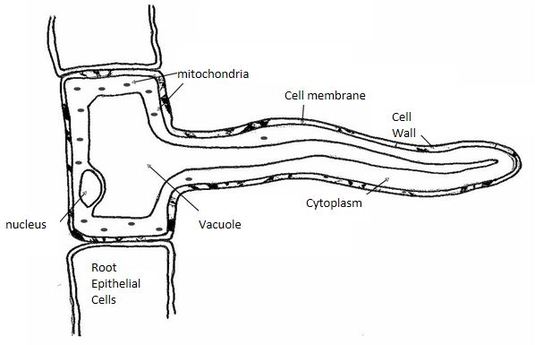
- support and exposure of leaves and flowers to the environment,
- conducting water and mineral salts
- conducting manufactured food from leaves to other parts of the plant.
- In monocotyledonous stems, vascular bundles are scattered all over the stem, while in dicotyledonous stems vascular bundles are arranged in a ring.
- Vascular bundles are continuous from root to stems and leaves.
- The epidermis forms a single layer of cells enclosing other tissues.
- The outer walls of the cells have waxy cuticle to prevent excessive loss of water.
- The cortex is a layer next to the epidermis.
- It has collenchyma, parenchyma and schlerenchyma cells.
Collenchyma
- Is next to the epidermis and has thickened walls at the corners which strengthen the stem.
- Cells are irregular in shape, thin walled and loosely arranged hence creating intercellular spaces filled with air.
- They are packing tissues and food storage areas.
Sclerenchyma
- Cells are closely connected to vascular bundles.
- These cells are thickened by deposition of lignin and they provide support to plants.
- Is the central region having parenchyma cells.
Absorption of Water
- Root hair cell has solutes in the vacuole and hence a higher osmotic pressure than the surrounding soil water solution.
- Water moves into the root hair cells by osmosis along a concentration gradient.
- This makes the sap in the root hair cell to have a lower osmotic pressure than the surrounding cells.
- Therefore water moves from root hair cells into the surrounding cortex cells by osmosis.
- The process continues until the water gets into the xylem vessels.
Uptake of Mineral Salts
- If the concentration of mineral salts in solution is greater than its concentration in root hair cell, the mineral salts enter the root hair cell by diffusion.
- If the concentration of mineral salts in the root hair cells is greater than in the soil water, the mineral salts enter the root hairs by active transport.
- Most minerals are absorbed in this way.
- Mineral salts move from cell to cell by active transport until they reach the xylem vessel.
- Once inside the xylem vessels, mineral salts are transported in solution as the water moves up due to root pressure, capillary attraction and cohesion and adhesion forces.
Transpiration
- Transpiration is the process by which plants lose water in the form of water vapour into the atmosphere.
- Water is lost through stomata, cuticle and lenticels.
Stomatal Transpiration:
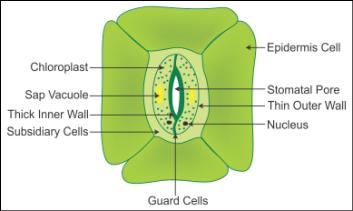
- This accounts for 80-90% of the total transpiration in plants.
- Stomata are found on the leaves.
Cuticular Transpiration:
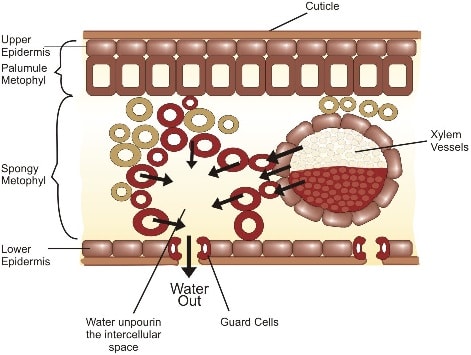
- The cuticle is found on the leaves, and a little water is lost through it.
- Plants with thick cuticles do not lose water through the cuticle.
Lenticular Transpiration
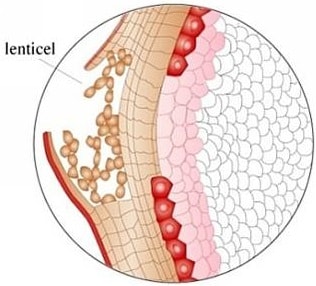
- Is loss' of water through lenticels.
- These are found on stems of woody plants.
- Water lost through the stomata and cuticle by evaporation leads to evaporation of water from surfaces of mesophyll cells .
- The mesophyll cells draw water from the xylem vessels by osmosis.
- The xylem in the leaf is continuous with xylem in the stem and root.
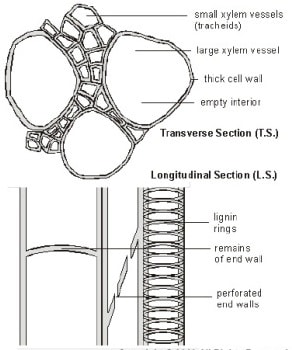
- Movement of water is through the xylem.
- Xylem tissue is made up of vessels and tracheids.
Xylem Vessels
- Xylem vessels are formed from cells that are elongated along the vertical axis and arranged end to end.
- During development, the cross walls and organelles disappear and a continuous tube is formed.
- The cells are dead and their walls are strengthened by deposition of lignin.
- The lignin has been deposited in various ways.
- Simple spiral.
- Double spiral.
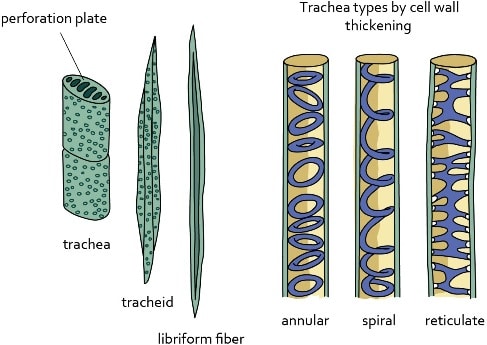
- The bordered pits are areas without lignin on xylem vessels and allow passage of water in and out of the lumen to neighbouring cells.
- Tracheids have cross-walls that are perforated.
- Their walls are deposited with lignin.
- Unlike the xylem vessels, their end walls are tapering or chisel-shaped.
- Their lumen is narrower.
- Besides transport of water, xylem has another function of strengthening the plant which is provided by xylem fibres and xylem parenchyma.
Xylem Fibres ;
- Are cells that are strengthened with lignin.
- They form wood.
Xylem Parenchyma:
- These are cells found between vessels.
- They form the packing tissue.
Transpiration Pull
- As water vaporises from spongy mesophyll cells into sub-stomatal air spaces, the cell sap of mesophyll cells develop a higher osmotic pressure than adjacent cells.
- Water is then drawn into mesophyll cells by osmosis from adjacent cells and finally from xylem vessels.
- A force is created in the leaves which pulls water from xylem vessels in the stem and root.
- This force is called transpiration pull.
Cohesion and Adhesion:
- The attraction between water molecules is called cohesion.
- The attraction between water molecules and the walls of xylem vessels is called adhesion.
- The forces of cohesion and adhesion maintain a continuous flow of water in the xylem from the root to the leaves.
Capillarity:
- Is the ability of water to rise in fine capillary tubes due to surface tension.
- Xylem vessels are narrow, so water moves through them by capillarity.
Root Pressure:
- If the stem of a plant is cut above the ground level, it is observed that cell sap continues to come out of the cut surface.
- This shows that there is a force in the roots that pushes water up to the stem.
- This force is known as root pressure.
- Transpiration leads to excessive loss of water if unchecked.
Some beneficial effects are:
- Replacement of water lost during the process.
- Movement of water up the plant is by continuous absorption of water from the soil.
- Mineral salts are transported up the plant.
- Transpiration ensures cooling of the plant in hot weather.
- Excessive loss of water leads to wilting' and eventually death if water is not available in the soil.
The factors that affect transpiration are grouped into two. i.e. environmental and structural.
Environmental Factors
Temperature
- High temperature increases the internal temperature of the leaf which in turn increases kinetic energy of water molecules which increases evaporation.
- High temperatures dry the air around the leaf surface maintaining a high concentration gradient.
- More water vapour is therefore lost from the leaf to the air.
- The higher the humidity of the air around the leaf, the lower the rate of transpiration.
- The humidity difference between the inside of the leaf and the outside is called the saturation deficit.
- In dry atmosphere, the saturation deficit is high.
- At such times, transpiration rate is high.
- Wind carries away water vapour as fast as it diffuses out of the leaves.
- This prevents the air around the leaves from becoming saturated with vapour.
- On a windy day, the rate of transpiration is high.
Light Intensity
- When light intensity is high; more stomata open hence high rate of transpiration.
Atmospheric Pressure
- The lower the atmospheric pressure the higher the kinetic energy of water molecules hence more evaporation.
- Most of the plants at higher altitudes where atmospheric pressure is very low have adaptations to prevent excessive water-loss.
Availability of Water
- The more water there is in the soil, the more is absorbed by the plant and hence a lot of water is lost by transpiration.
Structural Factors
- Plants growing in arid or semi-arid areas have leaves covered with a thick waxy cuticle.
- The more the stomata, the higher the rate of transpiration.
- Xerophytes have few stomata which reduce water-loss.
- Some have sunken stomata which reduces the rate of transpiration as the water vapour accumulates in the pits.
- Others have stomata on the lower leaf surface hence reducing the rate of water-loss.
- Some plants have reversed stomatal rhythm whereby stomata close during the day and open at night.
- This helps to reduce water-loss.
Leaf Size and Shape
- Plants in wet areas have large surface area for transpiration.
- Xerophytes have small narrow leaves to reduce water-loss.
- The photometer can be used to determine transpiration in different environmental conditions.
Translocation of Organic Compounds
- Translocation of soluble organic products of photosynthesis within a plant is called translocation.
- It occurs in phloem in sieve tubes.
- Substances translocated include glucose, amino acids, vitamins.
- These are translocated to the growing regions like stem, root apex, storage organs e.g. corms, bulbs and secretory organs such as nectar glands.
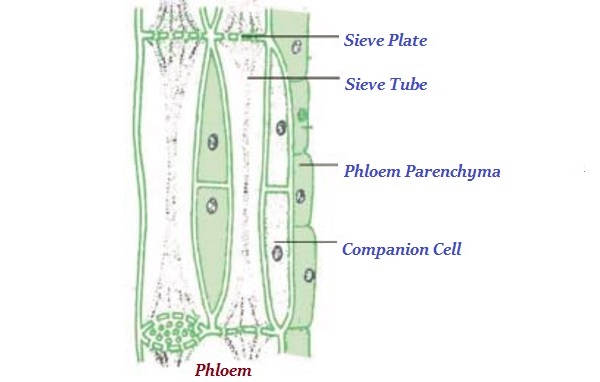
phloem is made up of;
- sieve tubes,
- companion cells
- parenchyma, a packing tissue
- schlerenchyma, a strengthening tissue
Sieve Tubes
- These are elongated cells arranged end to end along the vertical axis.
- The cross walls are perforated by many pores to make a sieve plate.
- Most organelles disappear and those that remain are pushed to the sides of the sieve tube.
- Cytoplasmic strands pass through the pores in the plate into adjacent cells.
- Food substances are translocated through cytoplasmic strands.
Companion Cells
- Companion cells are small cells with large nuclei and many mitochondria.
- They are found alongside each sieve element.
- The companion cell is connected to the tube through plasmodesmata.
- The mitochondria generate energy required for translocation.
Phloem Parenchyma
- These are parenchyma cells between sieve elements.
- They act as packing tissue.
Transport in Animals
- Large and complex animals have circulatory systems that consist of tubes, a transport fluid and a means of pumping the fluid.
- Blood is the transport fluid which contains dissolved substances and cells.
- The tubes are blood vessels through which dissolved substances are circulated around the body.
- The heart is the pumping organ which keeps the blood in circulation.
The types of circulatory system exist in animals: open and closed.
In an open circulatory system;
- The heart pumps blood into vessels which open into body spaces known as haemocoel.
- Blood comes into contact with tissues.
A closed circulatory system;
- Found in vertebrates and annelids where the blood is confined within blood vessels and does not come into direct contact with tissues.
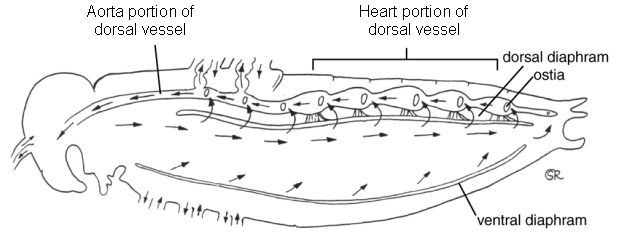
- In an insect, there is a tubular heart just above the alimentary canal.
- This heart is suspended in a pericardial cavity by ligaments.
- The heart has five chambers and extends along the thorax and abdomen.
- Blood is pumped forwards into the aorta by waves of contractions in the heart.
- It enters the haemocoel and flows towards the posterior.
- The blood flows back into the heart through openings in each chamber called ostia.
- The ostia have valves which prevent the backflow of blood.
- Blood is not used as a medium for transport of oxygen in insects.
- This is because oxygen is supplied directly to the tissues by the tracheal system.
- The main functions of blood in an insect are to transport nutrients, excretory products and hormones.
Mammalian Circulatory System
- Mammals have a closed circulatory system where a powerful heart pumps blood into arteries.
- The arteries divide into smaller vessels called arterioles.
- Each arteriole divides to form a network of capillaries inside the tissues.
- The capillaries eventually re-unite to form venules, which form larger vessels called veins.
- The veins take the blood back to the heart.
- Blood from the heart goes through the pulmonary artery to the lungs and then back to the heart through pulmonary vein.
- This circulation is called pulmonary circulation.
- Oxygenated blood leaves the heart through the aorta and goes to all the tissues of the body.
- From the tissues, deoxygenated blood flows back to the heart through the vena cava.
- This circulation is called systemic circulation.
- In each complete circulation, the blood flows into the heart twice.
- This is called double circulation.
- Some other animals like fish have a single circulation.
- Blood flows only once through the heart for every complete circuit.
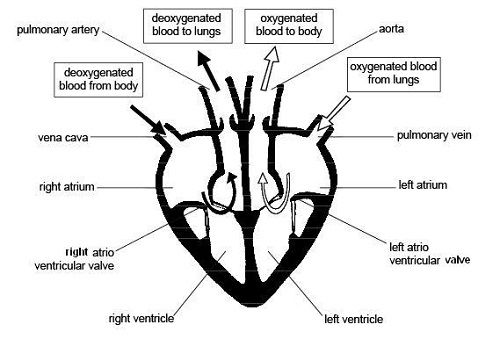
- The heart has four chambers:
- Two artria (auricles) and two ventricles.
- The left and right side of the heart are separated by a muscle wall (septum) so that oxygenated and deoxygenated blood does not mix.
- Deoxygenated blood from the rest of the body enters the heart through the vena cava.
- Blood enters the right atrium, then through tricuspid valve into right ventricle.
- Then via semi-lunar valve to the pulmonary artery to the lungs.
- Oxygenated blood from the lungs enters the heart through pulmonary vein.
- It enters the left atrium of the heart, then through bicuspid valve into left ventricle.
- Then via semi-lunar valves to aorta which takes oxygenated blood round the body.
- A branch of the aorta called coronary artery supplies blood to the heart muscle.
- The coronary vein carries blood from the heart muscle to the pulmonary artery which then takes it to the lungs for oxygenation.
- The heart undergoes contraction (systole) and relaxation (diastole).
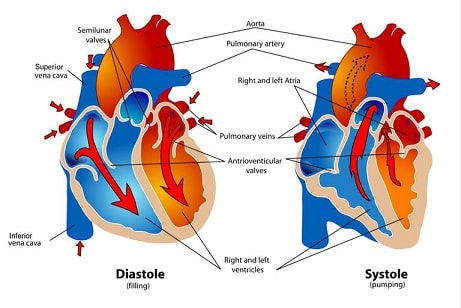
- When the ventricular muscles contract, the cuspid valves (tricuspid and bicuspid) close preventing backflow of blood into auricles.
- The volume of the ventricles decreases while pressure increases.
- This forces blood out of the heart to the lungs through semi-lunar valves and pulmonary artery, and to the body tissues via semi-lunar valve and aorta respectively.
- At the same time the atria are filled with blood.
- The left ventricle has thicker muscles than the right ventricle, and pumps blood for a longer distance to the tissues.
- When ventricular muscles relax, the volume of each ventricle increases while pressure decreases.
- Contractions of atria force the bicuspid and tricuspid valves to open allowing deoxygenated blood from right atrium into right ventricle which oxygenated blood flows from left atrium into the left ventricle.
- Semi-lunar valves close preventing the backflow of blood into ventricles.
- The slight contractions of atria force the , blood flow into ventricles.
The Heartbeat
- The heart is capable of contracting and relaxing rhythmically without fatigue due to its special muscles called cardiac muscles.
- The rhythmic contraction of the heart arise from within the heart muscles without nervous stimulation.
- The contraction is said to be myogenic.
- The heartbeat is initiated by the pacemaker or sino-artrio-node (SAN) which is located in the right atrium.
- The wave of excitation spreads over the walls of atria.
- It is picked by the artrio-ventricular node which is located at the junction of the atria and ventricles, from where the purkinje tissue spreads the wave to the walls of the ventricles.
- The heart contracts and relaxes rhythmically at an average rate of 72 times per minute.
- The rate of the heartbeat is increased by the sympathetic nerve, while it is slowed down by the vagus nerve.
- Heartbeat is also affected by hormones e.g. adrenaline raises the heartbeat.
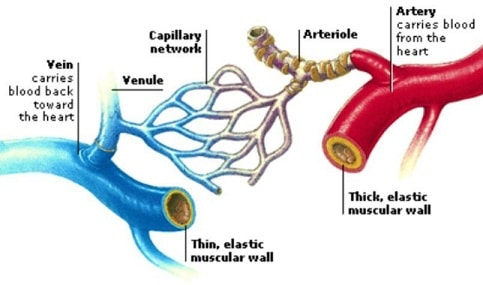
- Arteries carry blood away from the heart.
- They carry oxygenated blood except pulmonary artery which carries deoxygenated blood to the lungs.
- Arteries have a thick, muscular wall, which has elastic and collagen fibres that resist the pressure of the blood flowing in them.
- The high pressure is due to the pumping action of the heart.
- The pressure in the arteries originate from the pumping action of the heart.
- The pulse or number of times the heart beats per minute can be detected by applying pressure on an artery next to the bone. e.g. by placing the finger/thumb on the wrist.
- The innermost layer of the artery is called endothelium which is smooth.
- It offers least possible resistance to blood flow.
- Have a narrow lumen.
- The aorta forms branches which supply blood to all parts of the body.
- These arteries divide into arterioles which further divide to form capillaries.
Capillaries
- Capillaries are small vessels whose walls are made of endothelium which is one cell thick.
- This provides a short distance for exchange of substances.
- Capillaries penetrate tissues,
- The lumen is narrow therefore blood flowing in capillaries is under high pressure.
- Pressure forces water and dissolved substances out of the blood to form tissue fluid.
- Exchange of substances occurs between cells and tissue fluid.
- Part of the tissue fluid pass back into capillaries at the venule end.
- Excess fluid drains into small channels called lymph capillaries which empty their contents into lymphatic vessels.
- Capillaries join to form larger vessels called venules which in turn join to form veins which transport blood back to the heart.
- Veins carry deoxygenated blood from the tissues to the heart (except pulmonary vein which carries oxygenated blood from the lungs to the heart).
- Veins have a wider lumen than arteries.
- Their walls are thinner than those of arteries.
- Blood pressure in the veins is low.
- Forward flow of blood in veins is assisted by contraction of skeletal muscles, hence the need for exercise.
- Veins have valves along their length to prevent backflow of blood.
- This ensures that blood flows towards the heart.
- The way the valves work can be demonstrated on the arm.
- By pressing on one vein with two fingers, leaving one and pushing blood toward the heart then releasing the latter finger, it can be observed that the part in between is left with the vein not visible.
- This is because blood does not flow back towards the first finger.
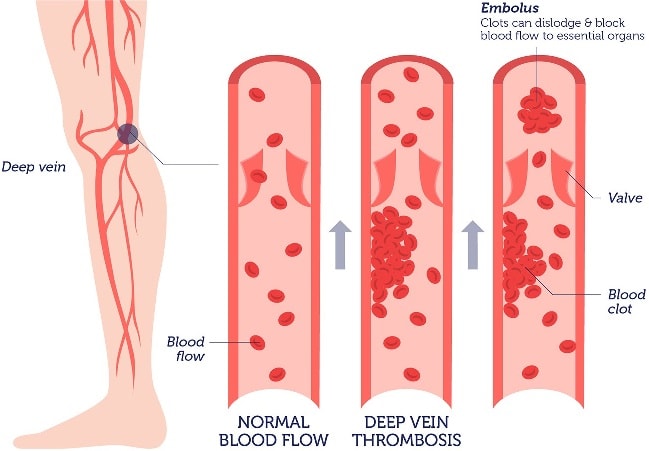
- Formation of a clot in the blood vessels is called thrombosis.
- Coronary thrombosis is the most common.
- It is caused by blockage of coronary artery which supplies blood to the heart.
- Blockage may be due to artery becoming fibrous or accumulation of fatty material on the artery walls.
- Narrow coronary artery results in less blood reaching the heart muscles.
- A serious blockage can result in heart attack which can be fatal.
- Heavy intake of fat, alcohol, being overweight and emotional stress can cause coronary thrombosis.
- A blockage in the brain can lead to a stroke causing paralysis of part of the body, coma or even death.
- A healthy lifestyle, avoiding a lot of fat in meals and avoiding alcohol can control the disease.
Arteriosclerosis
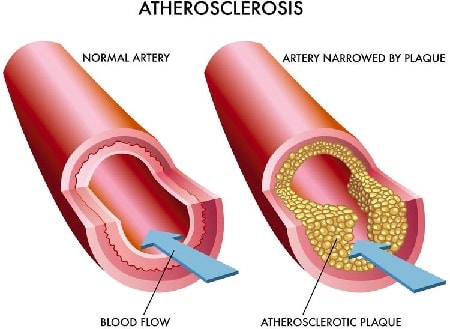
- This condition results from the inner walls having materials being deposited there or growth of fibrous connective tissue.
- This leads to thickening of the wall of the artery and loss of elasticity.
- Normal blood flow is hindered.
- Arteriosclerosis can lead to thrombosis or hypertension.
- A person with hypertension which is also called high blood pressure has his/her blood being pumped more forcefully through the narrow vessels.
- This puts stress on the walls of the heart and arteries.
- Regular exercise, healthy diet and avoiding smoking can help maintain normal blood pressure.
Varicose Veins
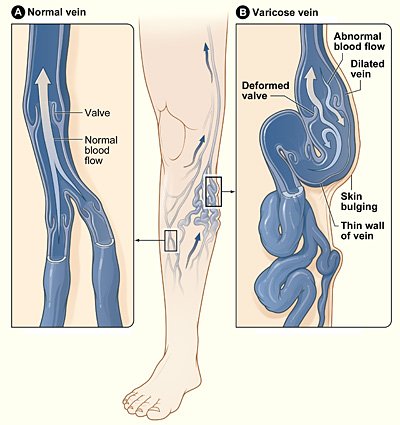
- Superficial veins especially at the back of the legs become swollen and flabby due to some valves failing to function properly.
- This results to retention of tissue fluid.
- Regular physical exercise will prevent this condition.
- Repair of valves through surgery can also be done.
- Wearing surgical stockings may ease a mild occurence.
Structure and Function of Blood
- The mammalian blood is made up of a fluid medium called plasma with substances dissolved in it.
- erythrocytes (red blood cells),
- leucocytes (white blood cells)
- thrombocytes (platelets)
- blood proteins.
- This is a pale yellow fluid consisting of 90% water.
- glucose, amino acids, lipids, salts,
- hormones, urea, fibrinogen, albumen,
- antibodies, some enzymes suspended cells.
- Serum is blood from which fibrinogen and cells have been removed.
The functions of plasma include:
- Transport of red blood cells which carry oxygen.
- Transport dissolved food substances round the body.
- Transport metabolic wastes like nitrogenous wastes and carbon (IV) oxide in solution about 85% of the carbon (IV) oxide is carried in form of hydrogen carbonates.
- Transport hormones from sites of production to target organs.
- Regulation of pH of body fluids.
- Distributes heat round the body hence regulate body temperature.
Erythrocytes (Red Blood Cells)
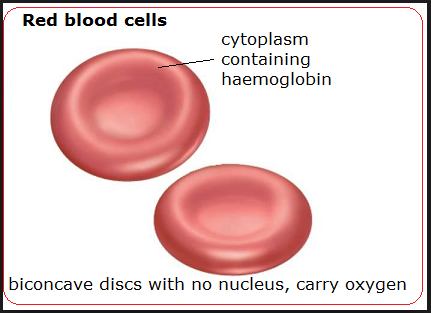
- In humans these cells are circular biconcave discs without nuclei.
- Absence of nucleus leaves room for more haemoglobin to be packed in the cell to enable it to carry more oxygen.
- Haemoglobin contained in red blood cells is responsible for the transport of oxygen.
- Haemoglobin + Oxygen =oxyhaemoglobin (Hb) + (4O 2 ) __ (HbO g )
- Oxygen is carried in form of oxyhaemoglobin.
- Haemoglobin readily picks up oxygen in the lungs where concentration of oxygen is high.
- In the tissues, the oxyhaemoglobin breaks down (dissociates) easily into haemoglobin and oxygen.
- Oxygen diffuses out of the red blood cells into the tissues.
- Haemoglobin is then free to pick up more oxygen molecules.
- The biconcave shape increases their surface area over which gaseous exchange takes place.
- Due to their ability, they are able to change their shape to enable themselves squeeze inside the narrow capillaries.
- CO 2 + H 2 O carbonic anhydrase
- There are about five million red blood cells per cubic millimetre of blood.
- They are made in the bone marrow of the short bones like sternum, ribs and vertebrae.
- In the embryo they are made in the liver and spleen.
- Erythrocytes have a life span of about three to four months after which they are destroyed in the liver and spleen.
- Also in the red blood cells is carbonic anhydrase which assists in the transport of carbon (IV) oxide.
Leucocytes (White Blood Cells)
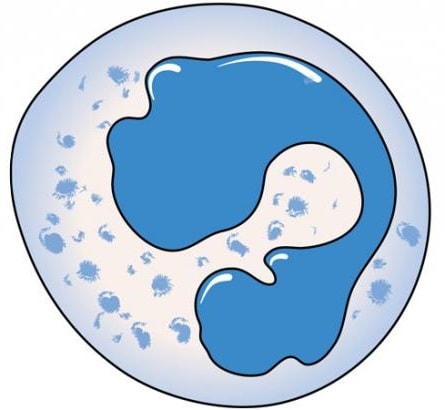
- These white blood cells have a nucleus.
- Granulocytes (also phagocytes or polymorphs)
- Agranulocytes
- White blood cells defend the body against disease.
- Neutrophils form 70% of the granulocytes.
- Others are eosinophils and basophils.
- About 24% agronulocytes are called lymphocytes, while 4% agranulocytes are monocytes.
- The leucocytes are capable of amoebic movement.
- They squeeze between the cells of the capillary wall to enter the intercellular spaces.
- They engulf and digest disease causing organisms (pathogens) by phagocytosis.
- Some white blood cells may die in the process of phagocytosis.
- The dead phagocytes, dead organisms and damaged tissues form pus.
- Lymphocytes produce antibodies which inactivate antigens. Antibodies include:
- Antitoxins which neutralise toxins.
- Agglutinins cause bacteria to clump together and they die.
- Lysins digest cell membranes of microorganisms.
- Opsonins adhere to outer walls of microorganisms making it easier for phagocytes to ingest them.
- Lymphocytes' are made in the thymus gland and lymph nodes.
- There are about 7,000 leucocytes per cubic millimetre of blood.
Platelets (Thrombocytes)

- Platelets are small irregularly shaped cells formed from large bone marrow cells called megakaryocytes.
- There are about 250,000 platelets per cubic millimetre of blood.
- They initiate the process of blood clotting.
- The process of clotting involves a series of complex reactions whereby fibrinogen is converted into a fibrin clot.
- When blood vessels are injured platelets are exposed to air and they release thromboplastin (thrombokinase) which initiates the blood clotting process.
- Thromboplastin neutralises heparin the anti-clotting factor in blood and activates prothrombin to thrombin.
- The process requires calcium ions and vitamin K.
- Thrombin activates the conversion of fibrinogen to fibrin which forms a meshwork of fibres on the cut surface to trap red blood cells to form a clot.
- The clot forms a scab that stops bleeding and protects the damaged tissues from entry of micro-organisms.
- Blood clotting reduces loss of blood when blood vessels are injured.
- Excessive loss of blood leads to anaemia and dehydration.
- Mineral salts lost in blood leads to osmotic imbalance in the body.
- This can be corrected through blood transfusion and intravenous fluid.
- There are four types of blood groups in human beings: A, B, AB and O.
- These are based on types of proteins on the cell membrane of red blood cells.
- There are two types of proteins denoted by the letters A and B which are antigens.
- In the plasma are antibodies specific to these antigens denoted as a and b.
- A person of blood group A has A antigens on the red blood cells and b antibodies in plasma.
- A person of blood group B has B antigens on red blood cells and a antibodies in plasma.
- A person of blood group AB has A and B antigens on red blood cells and no antibodies in plasma .
Blood transfusion is the transfer of blood from a donor to the circulatory system of the recipient.
A recipient will receive blood from a donor if the recipient has no corresponding antibodies to the donor's antigens.
If the donor's blood and the recipient's blood are not compatible, agglutination occurs whereby red blood cells clump together.
Blood Typing
- A person of blood group 0 can donate blood to a person of any other blood group.
- A person of blood group 0 is called a universal donor.
- A person of blood group AB can receive blood from any other group.
- A person with blood group AB is called a universal recipient.
- A person of blood group A can only donate blood to another person with blood group A or a person with blood group AB.
- A person of blood group B can only donate blood to somebody with blood group B or a person with blood group AB.
- A person with blood group AB can only donate blood to a person with blood group AB.
- Blood screening has become a very important step in controlling HIV/AIDS.
- It is therefore important to properly screen blood before any transfusion is done.
Rhesus Factor
- The Rhesus factor is present in individuals with the Rhesus antigen in their red blood cells.
- Such individuals are said to be Rhesus positive (Rh+), while those without the antigen are Rhesus negative (Rh-).
- If blood from an Rh+ individual is introduced into a person who is Rh- , the latter develops antibodies against the Rhesus factor.
- There may not be any reaction after this transfusion.
- However a subsequent transfusion with Rh+ blood causes a severe reaction, and agglutination occurs i.e. clumping of red blood cells.
- The clump can block the flow of blood, and cause death.
- Erythroblastosis foetalis (haemolytic disease of the newborn) results when an Rh- mother carries an Rh+ foetus.
- This arises when the father is Rh+.
- During the latter stage of pregnancy, fragments of Rhesus positive red blood cells of the foetus may enter mother's circulation.
- These cause the mother to produce Rhesus antibodies which can pass across the placenta to the foetus and destroy foetal red blood cells.
- During the first pregnancy, enough antibodies are not formed to affect the foetus.
- Subsequent pregnancies result in rapid production of Rhesus antibodies by the mother.
- These destroy the red blood cells of the foetus, the condition called haemolytic disease of the newborn.
- The baby is born anaemic and with yellow eyes (jaundiced).
- The condition can be corrected by a complete replacement of baby's blood with safe healthy blood.
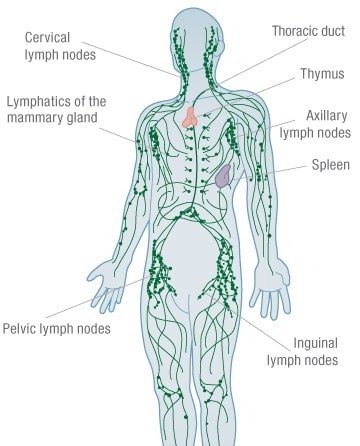
- The lymphatic system consists of lymph vessels.
- Lymph vessels have valves to ensure unidirectional movement of lymph.
- Lymph is excess tissue fluid i.e. blood minus blood cells and plasma proteins.
- Flow of lymph is assisted by breathing and muscular contractions.
- Swellings called lymph glands occur at certain points along the lymph vessels.
- Lymph glands are oval bodies consisting of connective tissues and lymph spaces.
- The lymph spaces contain lymphocytes which are phagocytic.
- Lymph has the same composition as blood except that it does not contain red blood cells and plasma proteins.
- Lymph is excess tissue fluid.
- Excess tissue fluid is drained into lymph vessels by hydrostatic pressure.
- The lymph vessels unite to form major lymphatic system.
- The main lymph vessels empty the contents into sub-clavian veins which take it to the heart.
Immune Responses
- Immune response is the production of antibodies in response to antigens.
- An antigen is any foreign material or organism that is introduced into the body and causes the production of antibodies.
- Antigens are protein in nature.
- An antibody is a protein whose structure is complementary to the antigen.
- This means that a specific antibody deals with a specific antigen to make it harmless.
- When harmful organisms or proteins invade the body, lymphocytes produce complementary antibodies, while bone marrow and thymus gland produce more phagocytes and lymphocytes respectively.
- Natural Immunity is also called innate immunity. It is inherited from parent to offspring.
- Artificial Immunity can be natural or induced. - attacked by diseases like chicken pox, measles and mumps, those who recover from these diseases develop resistance to any subsequent infections of the same diseases. This is natural acquired immunity.
Artificial Acquired Immunity:
- When attenuated (weakened) or dead microorganisms are introduced into a healthy person.
- The lymphocytes synthesis the antibodies which are released into the lymph and eventually reach the blood.
- The antibodies destroy the invading organisms.
- The body retains 'memory' of the structure of antigen.
- Rapid response is ensured in subsequent infections.
- Vaccines generally contain attenuated disease causing organisms.
Artificial Passive Acquired Immunity:
- Serum containing antibodies is obtained from another organism, and confers immunity for a short duration.
- Such immunity is said to be passive because the body is not activated to produce the antibodies.
- A vaccine is made of attenuated, dead or nonvirulent micro-organism that stimulate cells in the immune system to recognise and attack disease causing agent through production of antibodies.
- Vaccination protects individuals from infections of many diseases like smallpox, tuberculosis and poliomyelitis.
- Diseases like smallpox, tuberculosis and tetanus were killer diseases but this is no longer the case.
- Diphtheria Pertussis Tetanus (DPT) vaccine protects children against diphtheria, whooping cough and tetanus.
- Bacille Calmette Guerin (BCG) vaccine is injected at birth to children to protect them against tuberculosis.
- Measles used to be a killer disease but today, a vaccine injected into children at the age of nine months prevents it.
- At birth children are given an inoculation through the mouth of the poliomyelitis vaccine.
- An allergy is a hypersensitive reaction to an antigen by the body.
- The antibody reacts with the antigen violently.
- People with allergies are oversensitive to foreign materials like dust, pollen grains, some foods, some drugs and some air pollutants.
- Allergic reactions lead to production of histamine by the body.
- Histamine causes swelling and pain.
- Allergic reactions can be controlled by avoiding the allergen and administration of anti-histamine drugs.
Download TRANSPORT IN PLANTS AND ANIMALS - Form 2 Biology Notes .
Why download.
- ✔ To read offline at any time.
- ✔ To Print at your convenience
- ✔ Share Easily with Friends / Students
Related items
- Biology Paper 3 Questions - Kapsabet Boys Post Mock 2023 Exams
- Biology Paper 2 Questions - Kapsabet Boys Post Mock 2023 Exams
- Biology Paper 1 Questions - Kapsabet Boys Post Mock 2023 Exams
- Biology Paper 3 Questions and Answers With Confidential- Kenya High Post Mock 2023 Exams
- Biology Paper 2 Questions and Answers - Kenya High Post Mock 2023 Exams

access all the content at an affordable rate or Buy any individual paper or notes as a pdf via MPESA and get it sent to you via WhatsApp
What does our community say about us?
Join our community on:.

- KCSE Revision Questions
- Privacy Policy
- Mobile App Privacy Policy
- High Schools in Kenya
- Teacher Resources
- Questions and Answers
- Online Tuition and Classes in Kenya
Copyright © 2022 EasyElimu

Excretion and Homeostasis - High School Biology
Biology revision questions.

Want to enjoy learning? Try reading without Ads!
Join the elite club: unlock limitless learning.

Definition of Excretion
Excretion in plants, excretory products in plants: source and uses, excretion in animals, excretory products in animals, excretion and homeostasis in unicellular organisms, excretion in human beings, structure and function of the human skin.
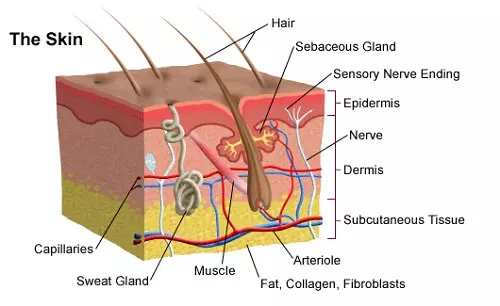
Nerve Endings
Subcutaneous fat, the lungs diagram.
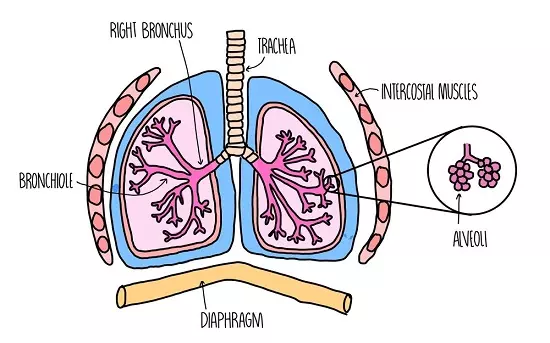
Functions of the Lungs
Structure and functions of the kidneys, the kidneys diagram.
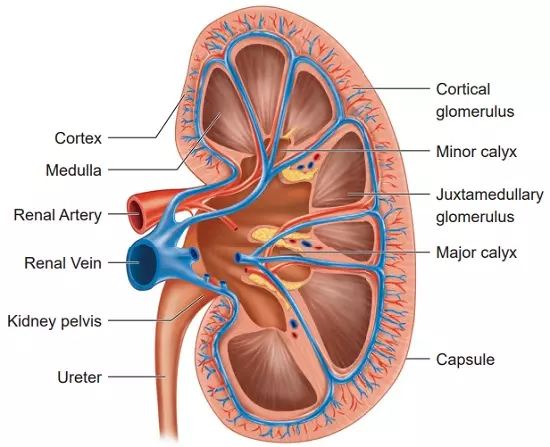
The Nephron
Mechanism of excretion, 1. filtration in the kidney, 2. selective reabsorption in kidney, common diseases of the kidney, symptoms of uraemia, kidney stones, treatment of kidney stones, c) nephritis, functions of the liver, excretion in the liver, breakdown and elimination of haemoglobin, elimination of sex hormones, liver diseases, liver cirrhosis, causes of liver cirrhosis, symptoms liver cirrhosis, control and treatment liver cirrhosis, 2. jaundice, causes of jaundice, symptoms of jaundice, homeostasis - definition of homeostasis, neuro-endocrine system and homeostasis, the skin and temperature regulation, homeostatic control of body temperature in humans, body size and heat loss, behavioural and physiological responses to temperature changes, skin and osmoregulation, the kidney and osmoregulation, excretion and homeostasis quiz, question - of -, hello esoma-ke member, please help review these notes. why review, students' and teachers' reviews, here's what our users had to say ....

School Base -Online
Saturday, december 10, 2022, biology form two topic 2: nutrition.

INTRODUCTION
Nutrition is the process by which organisms take in and use nutrients.Nutrients are any substances that nourish an organism.Food is any material when taken in absorbed and utilized meet requirement ofplant and animal body.
FUNCTION OF FOOD
- Oxidized to release energy
- Used in growth of cells
- Used to repair lost cells and tissue
TYPES OF NUTRITION
There are two main types of nutrition: autotrophic nutrition and heterotrophic nutrition.
Autotrophic Nutrition. Is the process by which organisms manufacture their own food from simpleinorganic substances like carbon and hydrogen using either light energy(photosynthesis) or chemical energy (chemosynthesis)
Heterotrophic Nutrition. Is the process in which organisms get nutrients by eating other organisms.
IMPORTANCE OF NUTRITION IN LIVING THINGS
- Prevent diseases
- Helps growth and development of cells, tissue and organs
- It helps to repair damaged parts
- It helps to protect the body against infection and diseases
NUTRITION IN MAMMALS, HUMAN NUTRITION.
Human Nutrition is the provision to obtain the essential nutrients necessary to support life and health.
OR Are several types of food substances that are needed by the human body for itsproper functioning.The basic food substances include proteins, carbohydrates, lipids, vitamins,minerals, roughage and water.
Different Types of Food Substances and their Functions in Human Body
These are substances, which contain elements oxygen and nitrogen.
SOURCE OF PROTEINS
Foods such as Meat, liver, eggs, beans, milk, cheese, peas, groundnuts and mushrooms are good sources of protein.
FUNCTION OF PROTEINS
The following are the function of protein
- It is used in body building
- Used by body for tissue growth and repair such as healing of wounds and replacement of skin
- Used as a source of energy, especially when the body lacks carbohydrates and lipids
- It enables red blood cells to transport oxygen in our bodies
CARBOHYDRATES
Carbohydrates are mainly made of carbon, hydrogen and oxygen
SOURCES OF CARBOHYDRATES
Foods such as maize, rice, bananas, potatoes, cassava, wheat (bread, cake) and yams are rich in carbohydrates.
FUNCTIONS OF CARBOHYDRATES
The following are the function of carbohydrates
- They are chief source of energy
- In plants they are stored as starch
- In animals they are stored as glycogen
These are compounds of carbon, hydrogen and oxygen. They are insoluble in water. Lipids are made up of fatty acid and glycogen
SOURCES OF LIPIDS
Foods such as fish, nuts, seed oils, avocados and olives are good sources of lipids.FUNCTIONS OF LIPIDS
- Lipids are used as a source of energy
- Protect the organs such as heart and kidneys
Vitamins are chemical substances in small amounts that are used to maintain the body.Vitamins can be grouped into two categories: water-soluble and fat-soluble vitamins. Fat-Soluble Vitamins can be stored in the body. Examples of fat-solublevitamins are Vitamins A, O, E and K
Water-Soluble Vitamins are not stored in the body. Vitamins B and C are water soluble.Vitamin B is of various forms, namely Vitamin B1, B2, B6 and B12.SOURCES,
FUNCTIONS AND SIGNS OF VITAMIN DEFICIENCIES
Certain mineral elements are vital for the proper functioning of the body. Someare required in relatively large quantities and therefore called macro mineralsand others are required in very small quantities and are referred to as micro
Macro minerals include calcium, phosphates, potassium, iron, zinc, sodiumchlorine and magnesium.
Micro minerals include iodine, fluoride, manganese and copper.Examples of minerals, their source and their function in the body
– This is dietary fiber that is obtained from the indigestible parts of plants.
SOURCES OF ROUGHAGE
Foods such as fruits, beans, cabbage, spinach, cassava, and whole baked potatoesare good sources of roughage.
FUNCTIONS OF ROUGHAGE
It helps in the passage of food and feces through the gut by aidingcontraction of the gut muscles
his is a compound containing element hydrogen and oxygen
SOURCES OF WATER
Rainfall, Rivers, Springs etc.
FUNCTIONS OF WATER
- Used in digestion of food
- Used in transport of material in the body
- Used as solvent in chemical reaction
The Concept of Balanced Diet in Terms of Food Quality and QuantityExplain the concept of balanced diet in terms of food quality and quantityA BALANCED DIETMeaning of balanced diet:A balanced diet refers to food containing all types of food nutrients in the correctproportions. We should eat a diet low in fats, sugars and salts but high in protein,carbohydrates, vitamins, minerals and roughage. More importantly we shouldtake in large amounts of water.IMPORTANCE OF A BALANCED DIETIn order for the body to function properly, different food substances are requiredto do different works for example:
- Carbohydrates provide energy
- Vitamins needed to keep the body healthy
- Minerals are needed for protection against diseases
- Water is a universal solvent
Nutritional Requirement for Different Groups of PeopleExplain nutritional requirement for different groups of peopleNUTRITIONAL REQUIREMENTS FOR DIFFERENT GROUPS OF PEOPLEThe following nutritional requirement
- Expectants: There diet should contain more protein and minerals (Calcium (Ca) and Iron (Fe))
- Lactating Mothers: Their requirements are like those of expectants butin greater amount to feed the body
- Children: Require a lot of proteins for growth and development of body tissue.
- The elderly People: They require adequate amounts of vitamins and minerals to maintain their health
- Sedentary workers: These are individuals who stay in one place for along time while performing their daily occupational activities. Due to their lifestyle and occupation,obesity is increasingly common among them, they limit their intake of food rich in lipids.
- Sick people: They need special and plenty of nutrients to help recover their health, those who have incurable diseases such as HIV/AIDS should get food that will help them to manage their conditions. They need totake plenty of fruits and water.
Different Types of Nutritional Deficiencies and Disorders in Human BeingsOutline different types of nutritional deficiencies and disorders in human beingsNUTRITIONAL DEFICIENCIES AND DISORDERSMalnutritionThis is the condition, which occurs when one fails to feed on a balanced diet. Itmay be too little or eating only one type. These deficiencies and disordersinclude obesity, rickets, kwashiorkor, marasmus and anorexia nervosa.Nutritional DisordersThese are conditions of ill health in a person, which arise as a result of lifestyle.The Causes, Symptoms, Effect and Control Measures of Nutritional Deficiencies and DisordersExplain the causes , symptoms, effect and control measures of nutritional deficiencies and disordersCauses of MalnutritionThere three cause of mulnutrition
- Eating too little
- Eating too much
- Eating one type of food
Effects of Malnutrition
- Excessive feeding causes obesity
- Under nutrition causes deficiency diseases
CAUSES, SYMPTOMS, EFFECTS AND PREVENTION MEASURES OFNUTRITIONAL DEFICIENCIES AND DISORDERS IN HUMAN BEINGS
Digestive System in Human DIGESTIVE SYSTEM IN HUMAN BEINGSThe digestive system of human refers to the human alimentary canal and theorgans and glands associated with it.Parts of the Human Digestive System and their Adaptive FeaturesIdentify parts of the human digestive System and their adaptive featuresTHE MAIN PARTS OF ALIMENTARY CANALThe main parts are:- Mouth, Oesophagus, stomach, small intestine, (duodenumand ileum), large intestine (colon) and rectum.ADAPTATIONS OF STOMACH TO ITS MODE OF FUNCTION
- Stomach has sphincter muscles to prevent food from flowing back into the oesophagus
- Stomach has gastric glands, which produce gastric juice for the digestive process.
- Also in the stomach of a young baby there is renin which coagulates milk
- Stomachs have mucus which protects it from corrosion by digestive enzymes
- There is hydrochloric acid for the emulsification of fats and killing ofbacteria
ADAPTATIONS OF ILLEUM TO ITS FUNCTIONSThe following are the adaptations of ileum to its mode of functions:-
- It has secretory glands, which produce digestive enzymes
- It is connected to the liver by the bile duct which enable the bile to reach ileum
- It has finger like projections called villi for the absorption of food
- The ileum is very long to ensure sufficient absorptions of food
- The villi have large network of blood capillaries for transporting absorbed food to all parts of the body
- The inner lining of the ileum is folded to increase the surface area forabsorption
The Digestion Process in Human BeingExplain the digestion process in process in human beingDIGESTION PROCESS IN HUMAN BEINGSDigestion is the process by which food is broken down into a form that can beabsorbed and used by the body.Digestion process involves two processes, which are mechanical break down offood and chemical break down of food. The mechanical break down of food takesplace in the mouth where the food is chewed by teeth so as to reduce it into smallpieces.Digestive enzymes achieve chemical break down of food. The digested food isabsorbed and assimilated in the body.The digestion process starts in the mouth where food is mechanically brokendown by teeth. The presence of food in the mouth stimulates the salivary glandto produce more saliva.FUNCTIONS OF SALIVA
- Have salivary amylase enzyme that converts starch into maltose
- To moisten the food
- To provide medium for enzyme reactions
- Have mucus to lubricate food for easy swallowing
- Saliva consists of Sodium and Calcium salt to ensure alkaline mediumfor amylase enzyme
Difference Between the Human Digestive System with that of Other MammalsCompare the human digestive system with that of other mammalsDIFFERENCES BETWEEN HUMAN DIGESTIVE SYSTEM AND RUMINANTS’DIGESTIVE SYSTEMThe ruminants’ digestive system differs from human digestive system in thefollowing ways:
- Ruminants have more elaborate system to enable cellulose digestion
- The stomach of ruminants have four chambers (rumen, reticulum,omasum, abomasum)
- The food is regurgitated, chewed, and again then passed to omasum.
Common Disorders and Diseases of the Human Digestive SystemOutline common disorders and diseases of the human digestive SystemDISORDERS AND DISEASE OF THE DIGESTIVE SYSTEMThese include diseases and disorders that affect teeth, oesophagus, stomach,small intestine and large intestinesExamples are:- dental caries, heart burn, ulcers, constipation and flatulence.
- Dental caries This is commonly referred to as tooth decay. It occurs when bacteriadestroy the outer part of the tooth.
- Heart burn Refers to the burning or painful sensation in the oesophagus. It is caused by regurgitation of hydrochloric acid in the stomach which leads to the irritation of oesophagus.
- Stomach ulcers Refers to the sore in stomach lining. It is caused by erosion of stomachwall due to enzyme reactions.
- Constipation Refers to the decrease in frequency of formation of stool. It occurswhen the stool becomes dry and hard due to excessive waterabsorption in the colon.
- Flatulence This is caused by excess gas in the digestive tract
Causes, Symptoms, Effects and Control Measures of Common Disorders and Diseases of the Human Digestive SystemExplain causes, symptoms, effects and control measures of common disorders and diseases of the human digestive systemSYMPTOMS OF DENTAL CARIES
- Holes in the teeth
CONTROL MEASURES TO CARIES
- Regular brushing of teeth
- Damaged teeth can be filled with artificial crown
- Minimization of intake of foods rich in sugar
- Avoid eating very hot or cold foods
- Have regular dental check ups
SYMPTOMS OF STOMACH ULCERS
- Burning pain in the stomach
- Nausea and vomiting
- Tiredness and weakness
- Blood in vomit or stool
CONTROL MEASURES TO STOMACH ULCERS
- Avoid smoking
- Avoid taking alcohol
- Avoid eating acidic foods
SYMPTOMS OF CONSTIPATION
- Lack of bowel movements for two or three days
- Hard stools
- The urge to go for long call even after you have just been to the toilet
PREVENTION OF CONSTIPATION
- Eat enough fibre
- Drink enough water
- Exercise regularly
- Seek medical help
CAUSES OF FLATULENCE
- Swallowed air
- Eating food that causes gas such as beans, cabbage, milk and onions
- Poor absorptions of carbohydrates
SYMPTOMS OF FLATULENCE
- Abdominal pain
- The constant urge to pass wind
- Excessive belching
- Accumulation of gas in the stomach
PREVENTION OF FLATULENCE
- Avoid foods that produce gas
- Chewing food properly
- Limit the amount of food which are
Nutrition in Plant, Mineral requirement in Plants Essential Mineral Element in Plant NutritionMention essential mineral element in plant nutritionThe mineral requirement in plant growth are categorized into two groups:
- Micro nutrients or minerals
- Macro nutrients
Macro nutrients are minerals that are required in a large quantity for the plant growth.They includeNitrogen, phosphorus, potassium, sulphur, sodium, magnesium, carbon, hydrogen,and oxygen.Micro nutrients; these are nutrients that are required in small amount for the plantgrowth.They include; iron, cobalt, fluoride, silicon, iodine, copper and zinkThe Roles of Essential Elements in Plant NutritionInvestigate the roles of essential elements in plant nutritionThe role of essential mineral elements in plant nutrition
Photosynthesis The Concept of PhotosynthesisExplain the concept of photosynthesisPhotosynthesis is the process where by green plants manufacture their own food byusing light energy produced from the sun. photosynthesis takes place in plantsespecially in leaves so as to make their own food by the presence of different factors.FACTORS FOR PHOTOSYNTHESISChlorophyll, corbondioxide, sunlight energy, mineral salts, temperature and water.Equation for photosynthesis:The Structure of the Leaf in Relation to PhotosynthesisDescribe the structure of the leaf in relation to photosynthesisThe petiole or leaf stalk attaches the leaf to the branch or stem. It keeps the lamina inposition that will enable it to get a maximum amount of sunlight. The lamina has alarge surface area, thus maximizes the absorption of light energy and carbondioxide.The lamina is also thin so that carbondioxide and light energy diffuse over a shotdistance to reach cells.The mid rib and veins contain xylem and phloem. Xylem vessels transport water andmineral salt to the leaf. Phloem vessels transport manufactured food to other parts ofthe plant.The Process of PhotosynthesisExplain the process of photosynthesisIt takes place inside the cell organelles known as chloroplasts. Photosynthesis takesplace in two stages the light stage and the dark stage.The Importance of Photosynthesis in the Real Life SituationOutline the importance of photosynthesis in the real life situationImportance of photosynthesis in daily life:
- All organisms which are heterotrophy depend on autotrophy as source offood.
- Living organisms depend on oxygen for their aerobic respiration producedduring photosynthesis
- . Photosynthesis convert light energy into chemical energy which is used byother organisms
- . Humans depend on photosynthesis for the energy containing fossil fuelwhich have developed over a millions of year.
Properties of Food Substance The Basic Food Substances and Their PropertiesMention the basic food substances and their propertiesBasic food substances:
- i. Carbohydrates
CARBOHYDRATESIs the kind of food substance nutrients made up of carbon, hydrogen, and oxygen.Example: cassava, maize, rice etc.TYPES OF CARBOHYDRATES
- Monosaccharide
- Disaccharide
- Polysaccharide
MONOSACCHARIDE:Monosaccharide is also known as simple sugar. They include glucose, fructose andgalactors. These sugars dissolve in water and form sweet solutions. Monosaccharideare reduced sugar. The general formulae for monosaccharide is (CH2O)nWhere “n” represents a number of carbon atoms and have a value between 3& 6.Example the formulae of glucose is (C6H12O6)Disaccharides:This is the kind of carbohydrate which is formed when two monosaccharidemolecules combine.Two glucose molecules combine to form maltose.(C6H12O6) + (C6H12O6) condensation – C12H22O11+ H2Osome disaccharide are reducing sugars example lactose and maltose , other are nonreducing sugar example sucrosePolysaccharides:Is the type of carbohydrates formed by condensation involving severalmonosaccharideExample starch, chitin etcProperties of polysaccharides:
- They are not soluble in water
- They are non reducing sugar
- . They are not sweet
- When put in water they form suspension
Common Reagents and Chemicals used to Determine Food PropertiesIdentify common reagents and chemicals used to determine food PropertiesTEST FOR CARBOHYDRATES
Food Tests for Reducing Sugars, Non Reducing Sugars, Starch, Proteins and Lipids (Fats and Oil)Carryout food tests for reducing sugars, non reducing sugars, starch, proteins and lipids (Fats and Oil)PROTEINS Food Processing, Preservation and Storage. The Concept of Food Processing , Food Preservation and Food StorageExplain the concept of food processing , food preservation and food storageFood processing refers to all the ways in which food is treated in order to make itedible, appetizing and safe to eat or to keep it fresh for a long time.Some of activities involved in food processing are;
- Picking, sorting and washing fruits and vegetables
- Cooking by boiling steaming, roasting backing or frying
- Converting raw materials into other products for example making cheersfrom milk or sugar from sugar cane
FOOD PRESERVATIONFood preservation refers specifically to the methods of food processing that areused to prevent food from spoiling or going badMethods of food preservation
- Keeping out micro organisms for example by canning or bottling
- Using high temperature to kill microorganisms that cause spoilage eg.By pasturalization and boiling
- Using very low temperature to slow down the growth of microorganisms for example refrigerationiv.
- Irradiation which is by using radiations such as gamma rays to killmicro organismsv
- Eliminating the moisture that is needed for growth of micro organismfor instance by drying, salting, smoking etc
- Adding chemicals such as salt sugar, carbon monoxide to preventphysical changes in food
FOOD STORAGERefers to the methods used to keep or reserve of food for future use. Foodstorage can be done on a small scale at the family level for example in afamily granary or food store. Or large scale for large populations e.g ingovernment stores of grains.The Importance of Food Processing, Preservation and StorageExplain the importance of food processing, preservation and storageThe following are the importance of food preservation
- prevents wastage of food
- it saves money by preventing spoilage of food
- maintains the quality of food
- prevents the growth of micro organisms that can cause illness
- improve the flavor of food
- removes armful toxins and micro organisms from food
- makes food available even where they are not in season
- enables transportation of delecate and perishable food such as milk andfruit over long distance
Traditional and Modern Methods of Processing, Preserving and Storing FoodDifferentiate between traditional and modern methods of processing, preserving and storing foodThey are two methods of food processing and preservation which are;
- traditional methods
- modern methods
TRADITIONAL METHODSThese are methods used to process and preserve food which doesn’t require the use oftechnology.These are methods used to process and preserve food which doesn’t require the use oftechnology. The following are the traditional ways.CURINGIt involves additional of substances such as salt, sugar, spaces and vinegar toanimal foods, moist meat and fish. Curing removes water making itunavailable for the growth of microorganism it also improve the taste of food.Sausages, becon and curried beef are made by curing meat.DRYING IN THE SUNThus method is used to preserve rice, maize, cloves, banana, beans, peas,meat, fish etc.Here food is left for long time on the sun in order to reduce its moisturecontent. Reducing the amount of water in food discourages the growth ofmicroorganisms. Some food such as banana and cassava are cut into smallpieces to fasten the process.SMOKINGSmoking is the traditional method which is used to reduce moisture content offood to prevent growth of microorganisms. Grains, meat, fish can be driedslowly over the smoking wood fireCOOKINGTraditional methods of cooking are simple and include boiling, steaming,backing, in hot hash and roasting. These processes help to soften food,improve flavor and preserve food. Example potatoes, bananas, and maize canbe boiled before being dried.STORAGE IN GRANARIES AND PITSDry grains are stored in granaries which are usually raised above the ground.The grains are sometimes mixed with neem leaf ash or groundnuts oil to further prevent attack by microorganisms.Granaries keep grains safe from insects rodents and birds. Example harvestedyams, potatoes and cassava can be stored in large pits in the ground after drying.ADVANTAGES OF TRADITIONAL METHODS OF FOOD PROCESSING ANDPRESERVATION AND STORAGE
- They are simple and they can be done by most people
- They use locally available materials and simple technology thus keeping costslow
- No harmful chemicals are added to the food
- Curing and smoking add distinct flavor.
- Most methods do not destroy nutrients
DISADVANTAGES:
- Food can be preserved and stored for the limited period of time
- They are manual and thus difficult to apply on a large scale
- Traditional methods are highly limited in the variety of food that can beprocessed preserved and stored.
MODERN METHODS OF FOOD PROCESSING AND PRESERVATIONREFRIGERATION AND FREEZINGIs the temporary storage of food at low temperature of up to 4 centigrade inorder to slow down the growth of microorganisms. Freezing involves storingfood at very low temperatures in order to stop the growth of microorganisms .frozen food can be kept for months.Food that can be refrigerated include milk, fresh fruits, vegetables, juice andbutter. Freezing is mostly used for meat, fish, fruits and vegetables.PASTEURIZATIONThus method of preservation was named after its inventor Louis Pasteur. Itinvolved heating food to a very highest temperature for a short time in order tokill the micro organisms that can cause spoilage.Pasteurization maintains the nutrients content and flavor of food. Examples offood that can be pasteurized are milk and fruity juice.CANNING AND BOTTLINGIn this method, food is preserved by heating it in airtight vacuum, sealedbottles or cans. The container is filled with food then the air is pumped out toform a vacuum. The container is sealed and heated to kill microorganisms andenzymes but not enough to overcook the food. Food that can be bottled orcanned include tomatoes, fruits, juice, beef, fish and packed beans. Bottled orcanned food can be kept for months or even years.USING ADDITIVESThis method involved the use of chemicals such as sodium benzoate, sodiumchloride, and vinegar are added to food to slow down the growth of microorganisms. This is commonly done to pressure fish and meatDRYINGFood is dried by using either hot blast of air from a vacuum drayer. Afterdrying the food is then sealed in moisture –proof containers.IRRADIATIONIs the modern method which involve the use of rays of energy to stop thegrowth of microorganisms in stored food. Example in onions, beans andpotatoes. This makes food last longer. It also prevents sprouting in onions andpotatoes.ADVANTAGES OF MODERM MOTHODS
- Food can last for many months and even a year
- Modern methods can process, preserve, and store large variety of food.
- They are advanced technology bused in fast and can handle huge quantities offood.
DISADVANTAGES;
- The chemicals used can be harmful if eaten in excess
- These advanced technology involve means where they are used only in certain areas for instance refrigeration requires electricity.
- The process used for example canning and pasteurizing require special skills.
- Sometimes nutrients are lost thus lowering the nutritional value of food
DIFFERENCES BETWEEN TRADITIONAL AND MODERN METHODS OFFOOD PROCESSING AND PRESERVATION
READ TOPIC 3

Thanks for reading BIOLOGY FORM TWO TOPIC 2: NUTRITION
No comments:
Post a comment.

IMAGES
VIDEO
COMMENTS
KCSE BIOLOGY BIOLOGY ESSAY QUESTIONS WITH MARK SCHEMES 1. Explain the various ways in which a typical cell is adapted to its functions ... 2. Explain how the various specialized cells are modified to carry out their functions in plants and animals ... light stage; to form glucose, proteins and lipids; low concentrations reduces the rate of
Attempt Form 2 Biology questions on Transportation in Plants, Transportation in Animals, Gaseous Exchange in Plants, Gaseous Exchange in Animals (respiration), Excretion, Homeostasis. Attempt Form 3 Biology revision questions on Classification II, Ecology, Adaptation of Plants, Pollution, Reproduction, External and internal fertilization in ...
Download. Form 2 Biology Questions and Answers. This document contains Biology Questions and Answers Form 2 Brief Overview: a) i) Define transport • Movement of substances from one part of the body to another ii) Explain the necessity of... Price: KES : 150.
Download Form 2 Biology Notes for free at no cost. These Biology notes follows the Kenya Certificate of Secondary Education Biology Form 2 syllabus. Our notes have been prepared by qualified professional teachers. Download these free notes in pdf/word formats and use them in your Biology class during teaching and/or revision. Form 2 Biology Notes.
18 exams and past papers. Get access to thousands of educational resources. Form 2 Biology End of Term 2 Examination 2023. Form 2 Biology Mid Term 1 Examination 2023. Form 2 Biology End of Term 3 Examination 2022. Form 2 Biology End of Term 2 Examination 2022. Form 2 Biology End of Term 3 Examination 2021. Form 2 Biology End Term 2 Exams 2021.
Join Kenya's Largest Teachers Telegram Group with Over 80K Teachers FORM 1-4 CLASS 7-8 GRADE 1-6 PP1-PP2 KASNEB PTE. Download all the high school Biology Notes, for form 1, form 2, form 3, and form 4. Included also are biology essay questions and answers.
BIOLOGY FORM THREE SUMMARIZED NOTES. Biology notes (Updated form one to four free notes) Biology Simplified Notes Form 1 to 4 Free. Biology Free notes and Exams for Form one to Four. BIOLOGY KCSE MARKING AND SETTING TIPS IN LINE WITH EMERGING TRENDS. Biology topical questions and answers. Biology KCSE Past Papers and all marking schemes free ...
Biology form 2 notes. Ksh230. This document contains biology form 2 complete notes which are suitable for both students and teachers.It is well analysed and prepared with the aim of preparing KCSE candidates for biology examination. In PDF format so that your print or read from any smartphone, laptop or computer. Click to Buy. Order on whatsapp.
FORM TWO- BIOLOGY FORM 2 Compiled & distributed by Schools Net Kenya, P.O. Box 15509-00503, Nairobi | Tel:+254202319748 E-mail: [email protected] | ORDER ANSWERS ONLINE at www.schoolsnetkenya.com Question 21 is compulsory Answer question 21 and either question 22 or 23
Biology Form 2 Revision Questions and Answers: Form Two Biology, Secondary School. Back to Revision Questions. Change Revision Questions Class Form 1 Questions Form 2 Questions Form 3 Questions Form 4 Questions. [email protected]. Esoma-KE. Esoma-KE HOME; PP1 - GRADE 3. PP1; PP2; GRADE 1; GRADE 2; GRADE 3; GRADE 4 - GRADE 7. GRADE 4; GRADE 5;
Answers should be written in the spaces provided. Define the following terms. (2mks) Taxon. Taxonomy. A donkey and a horse can breed and produce a young one called a mule. Explain why they do not belong to the same species. (2mks) Give one reason for each of the following operations in microscopy work. (3mks)
FORM TWO BIOLOGY SUMMARIZED NOTES. By the end of form two work, the learner should be able to: Define the term transport. List substances transported in plants and animals. Link surface area to volume ratio of organisms to the transport system of the organism. Explain the necessity of transport in plants. Draw the structure of roots and root hairs.
On this page, you will find examples of biology essays. You will also find here tips and topics prepared by our experts. They can assist you in nailing your short or extended essay. We will write a custom essay specifically for you. for only 11.00 9.35/page. 809 certified writers online. Learn More. Read more.
Animal tissues (2mks) Name three photosynthetic cells in plants (2mks) State three structural differences between arteries and veins (3mrk) Give two reasons why clotting of blood is important (2mks) Name one enzyme and one metal ion that are required in the blood clotting process 2mks)
Whether it's term 1, 2 or 3, these free biology form 2 revision topical questions will give you that grade A. Visit the EasyElimu App to get the answers to the topical revision questions for free. Alternatively, click the blue download button on this page to download, in PDF format, the specific topical revision questions with answers.
Back to TOPICAL QUESTIONS & ANSWERS menu Updated on 6/12/2023. Join Kenya's Largest Teachers Telegram Group with Over 80K Teachers FORM 1-4 CLASS 7-8 GRADE 1-6 PP1-PP2 KASNEB PTE. Biology Topic By Topic Questions and Answers for All Topics in Form 1, Form 2, Form 3 and Form 4 for Kenya Secondary Schools in preparation for KCSE .
BIOLOGY. FORM II. TIME: 2 HOURS. JOINT EVALUATION EXAMINATION. TERM 3. INSTRUCTIONS TO CANDIDATES. Write your name and admission number in the spaces provided above. Answer ALL questions in the spaces provided. All working must be clearly shown where necessary.
Here are KCSES 2022/2023 Biology Essay Questions and Answers (KCSE 2022 Prediction Questions).Content: 31 pages with 60 questions and answers. BIOLOGY (231/2) Revision Questions (Essays): Expected Responses
Introduction to Transport in Plants and Animals. Transport is the movement of substances within an organism. All living cells require oxygen and food for various metabolic processes. These substances must be transported to the cells. Metabolic processes in the cells produce excretory products which should be eliminated before they accumulate.
Short answer questions. Short answer questions range from a sentence or two through to a paragraph in length. Keep to the point. Short answers are usually two-three sentences. Main ideas. Your answers should incorporate the key points, words, ideas and phrases the marker will be looking for. Leave one or two lines after each answer.
Introduction. Transport is the movement of substances within an organism. All living cells require oxygen and food for various metabolic processes. These substances must be transported to the cells. Metabolic processes in the cells produce excretory products which should be eliminated before they accumulate.
Definition of Excretion. - Excretion is the process by which living organisms separate and eliminate waste products of metabolism from body cells. - If these substances were left to accumulate, they would be toxic to the cells. - Egestion is the removal of undigested materials from the alimentary canals of animals.
Meat,vegetables,yeast extracts,whole grain cereals. Essential in protein metabolism. - Nerve irritability- Sores in the mouth and eyes- Anaemia. Vitamin B12 (Cyanocobalamin) Fish, meat,eggs, milk and liver. Builds genetic materials, help to form red blood cells. - Anaemia- Nerve damage- Weight Loss.